#peak dance iconography
Explore tagged Tumblr posts
Text
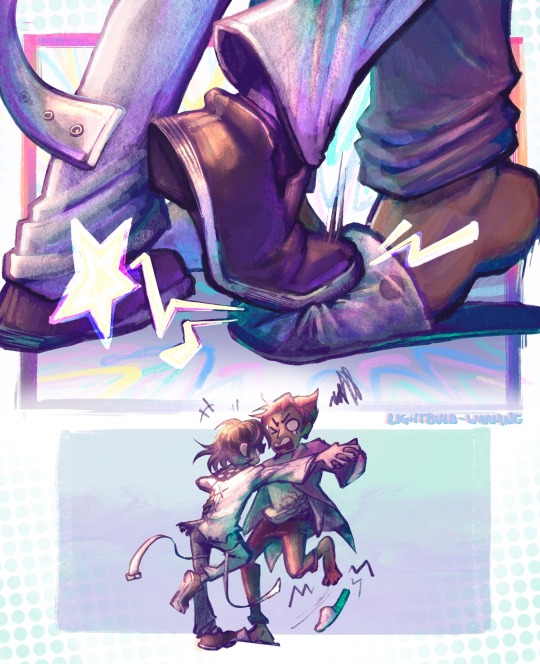
Oumota week 2023! Day three- dancing!!
You can hear Macklemore’s “And we danced” in the distance. You can’t tell where it’s coming from. With each of your heartbeats you can feel it get louder and louder. The walls shake as the bass boosts through you, from the bottom of your spine to your tongue between your teeth. Oh fuck, Its him. He’s behind you- Macklemore.
#maiora please shut up#oumota#oumotaweek2023#kokichi ouma#kaito momota#drv3#danganronpa fanart#my art#I am incredibly sleep deprived#take a shot every time you gonna see this exact dance pose today but slightly different#peak dance iconography#hell yeah#we love#maiora draws
607 notes
·
View notes
Text
The Best Spots for Making Disneyland TikTok Videos
TikTok has become hugely popular in recent years, with people creating fun 15 to 60 second videos set to music. Disneyland is a prime location for making engaging TikTok content. Guests are allowed to film TikTok videos throughout the Disneyland parks and resorts. When deciding where to film your Disneyland TikTok videos, it's best to choose locations that are less crowded so you don't disrupt other guests or block walkways. Quietest Places to Film - Main Street Cinema - This small theater rarely has crowds, making it perfect for filming dances or challenges. The vintage cinema seats also make a fun backdrop. - Court des Anges - The secluded courtyard in New Orleans Square offers shade trees, benches, and little foot traffic - ideal for recording solo or with a friend. - Hungry Bear Restaurant Outdoor Seating - Overlooking the Rivers of America, this area is consistently quiet and peaceful, with beautiful natural views. - Grand Californian Hotel Lobby - The grand, spacious lobby filled with plush couches allows ample room for filming. You can even order refreshments. Other solid options are the Animation Courtyard at California Adventure or Redwood Creek Challenge Trail in Grizzly Peak. Most Scenic Places - Pixar Pier at California Adventure - Offers colorful, vibrant views of the Incredicoaster, Toy Story Midway Mania, and other rides set against scenic Paradise Bay and the Pacific Ocean. - Grizzly Peak at California Adventure - Provides beautiful natural backdrops of forests, rivers, and mountains surrounding Grizzly River Run and the Redwood Creek Challenge Trail. - Rivers of America at Disneyland - Scenic waterway with options like the Mark Twain Riverboat, Columbia Sailing Ship, canoes, and wooded trails along the riverbanks. - Main Street USA at Disneyland - Charming, old-fashioned small town views of the entrance promenade lined with shops and attractions. - New Orleans Square at Disneyland - Picturesque themed land evoking vintage New Orleans French Quarter architecture and Mardi Gras colors. Other scenic spots cited include Cars Land at dusk, Paradise Gardens Park at night, Sleeping Beauty Castle walkthrough, and Mickey's Toontown facade. Areas with beautiful lighting, iconography related to rides, or water views tend to be popular backdrops. Best Rides to Film On - Star Wars: Rise of the Resistance - An immersive 15+ minute experience with impressive special effects, animatronics, and set design that makes for dramatic video footage. - Radiator Springs Racers - Offers scenic views of Cars Land and an exciting, fast-paced race component ideal for action videos. - Incredicoaster - This rollercoaster provides opportunities for fun reaction videos, with fast speeds and loops. - Pixar Pal-A-Around - Allows capturing an incredible view of the entire Park. - Guardians of the Galaxy - Mission Breakout - Video can showcase the randomized ride experiences and music, particularly the intense drops. Other top options include classics like Space Mountain, Indiana Jones, and Big Thunder Mountain. Rides with strong theming, speed, or iconic Disney features tend to make the most engaging video subjects. Tips for Making Food TikTok Videos - Keep it simple - Focus on one food item at a time. Simplicity helps videos be easily consumable and go viral. - Make it fun and engaging - Incorporate humor, interesting edits, music, and movement to capture attention. Over 83% of TikTokers have created their own videos, so inspire them. - Use top-down camera angles - Show every angle of the food. This optimized mobile viewing angle provides information quickly. - Highlight food details - Use good lighting and show all toppings and side items. - Tap into trends and seasonality - Connect content to popular food crazes and seasonal events that spark interest and searches. - Collaborate with creators - Partner with influencers to expand reach and authenticity. Combine organic content with paid partnerships. - Encourage easy participation - Inspire viewers to come and get their own. - Post consistently - Regularly upload new videos to build an audience and get more views. Short form content requires constant stimulation. When filming your TikToks, be sure to avoid blocking walkways or intruding on other guests' experiences. Additionally, never try to defeat safety measures on rides just for more dramatic footage, as Disney has warned this causes unsafe conditions. With so many fun backdrops across the Disneyland Resort, it’s a prime place for making engaging TikTok content - just be sure to do it safely and courteously! Read the full article
0 notes
Text
Restless Rewatch: The Untamed - Episode 02
Warning: Spoilers for all 50 episodes!
(Masterpost ) (Previous Episode) (Next Episode)
Donkey Riding
way ho and away we go, donkey riding donkey riding way ho and away we go, riding on a donkey
Wei Wuxian and Apple are doing their best for the Ministry of Culture and Tourism.

Xiao Zhan had trouble riding the donkey sitting side-saddle, so the Department of Questionable Practical Effects made him a fake leg to wear while riding regular style.
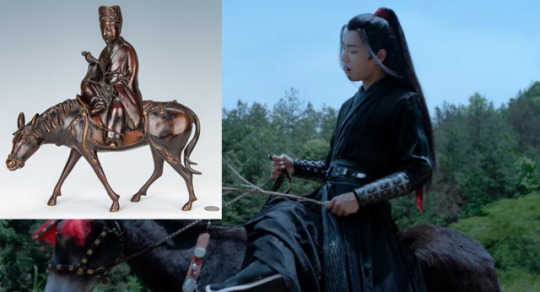
Can you spot it? It’s very hard to spot. It is very convincing.
Simple Pleasures
Wei Wuxian takes his time wandering up the nearest mountain, and half of the cultivators in the land also wander up this mountain because...Night Hunting! The cultivators are hot and thirsty from walking because they forgot that they all know how to fly.
Wei Wuxian relaxes by a well and listens to people stanning him.
Also
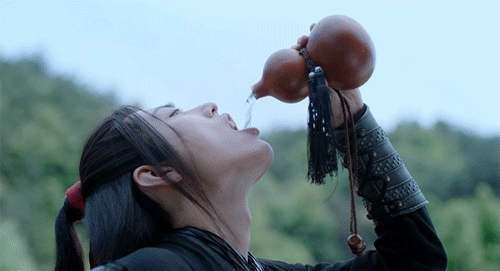
I’m going to say it: Wei Wuxian never met a drinking vessel he couldn’t blow.
Everything is Beautiful at the Ballet
The actress who plays A-Yan is named Zhang Linran. She probably has studied dance since she was 4 and now she gets her big break which turns out to be feeding an apple to a donkey. So let’s pause for a second to look at how beautifully she moves.
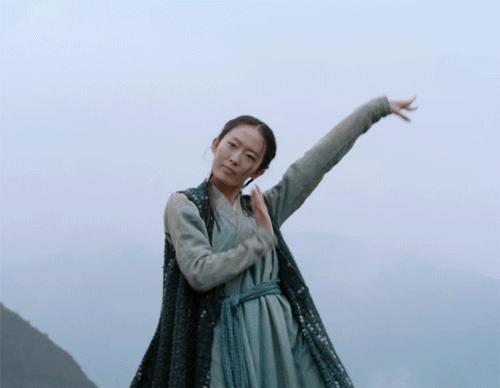
Reunions are Awkward, Part 1
Wei Wuxian meets up with one of his family members and it goes super well.
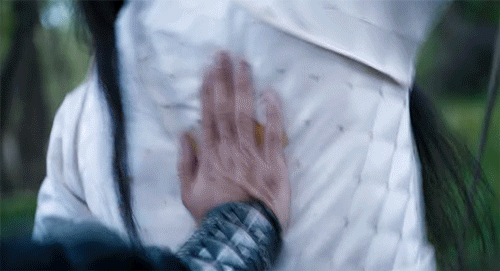
I...like Jin Ling? He’s much less of a douchebag than his dad, his uncles Jin, Jiang, and Mo (the three stooges), and every damn one of his Jin cousins. He’s genuinely brave (his Dad’s primary good quality) and his hair is on fleek. He’s still a whiny diaper baby, but I like him.
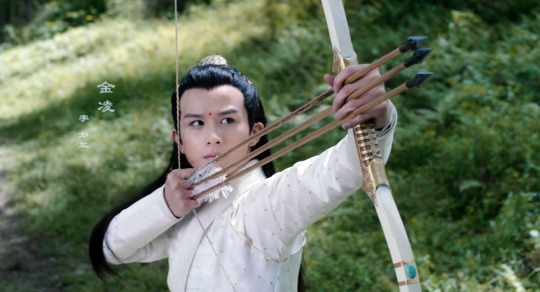
(much more after the cut!)
Then Jiang Cheng shows up, looking fine as hell and radiating peak arrogant-prick energy.

When he discovers that ‘Mo Xuanyu” stuck a piece of paper to Jin Ling, he tells the child to literally murder him. Excellent uncleing! A+++++ would recommend.
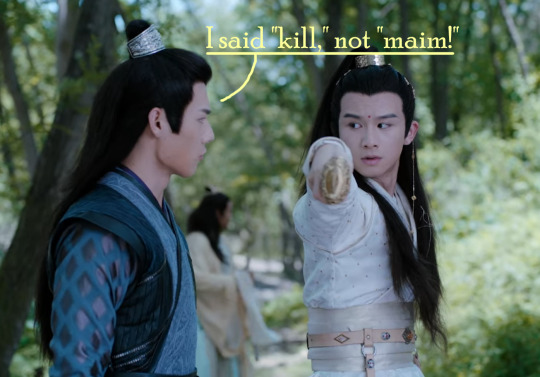
“In fact, literally murder anyone who uses Yiling Laozu’s tools, like talismans, lure flags, or spirit compasses - basically murder everyone in the Lan Clan plus those other fanboys we saw coming up the hill. Then get out there and make some friends, goddamn it!”

These nets full of cultivators on this daytime night hunt are the only time we ever see anything in a net during a night hunt. In fact dudes constantly go night hunting and the only prey we ever see is rock lady, murder turtle, and a couple of rag mops in the lake.
You Are Not Qualified to Speak to Me
Also radiating arrogant-prick energy on this occasion is Lan Wangji. He has been using pettiness as a weapon since long before he met this Jiang Cheng turkey, and he *brings it* when Jiang Cheng tries to have a conversation with him.


Letting your eyes wander everywhere except to his punchable face while you ignore his passive-aggressive questions? Quality work.
Dropping a silence spell on his child and then letting your own child explain it to him? Golden.
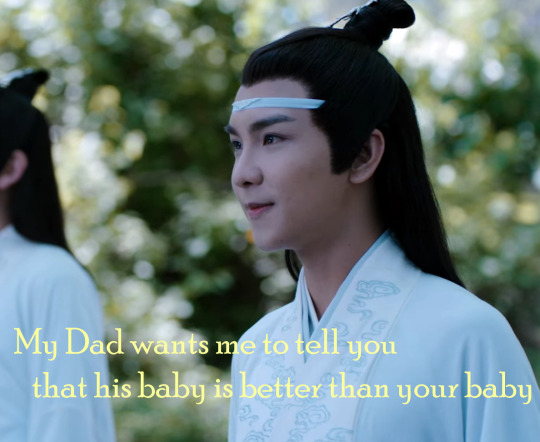
Lan Wangji is never ever going to forgive Jiang Cheng for what he did on cliff day, and his silence here is as pointed as an ice pick. I suspect the last words Lan Wangji actually spoke to him were “Jiang Wanyin, stop it,” sixteen years ago.
Jiang Cheng is actually the bigger person in this particular interaction, visibly mastering his temper and telling Jin Ling to take his medicine.
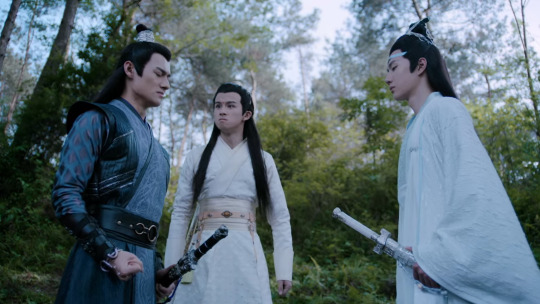
Reflecting
Wei Wuxian hangs out by a beautiful river and hallucinates for a while. River Jiang Yanli is nurturing and River Jiang Cheng is pissed off, so there are no surprises there. River Jiang Cheng thinks that Wei Wuxian is a promise-breaking douchebag. He’s not exactly wrong.

Courtesy of convenient gossiping cultivators, Wei Wuxian discovers that the 16 year old arrogant kid from the Jin clan who his brother from the Jiang clan has custody of is actually and quite obviously Jin Rulan.
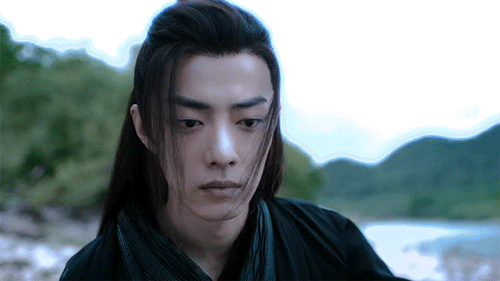
Well fuck I guess now I care about something, that’s inconvenient.
Needing to help parent the child of the sister who parented him is what draws Wei Wuxian fully into his new life.
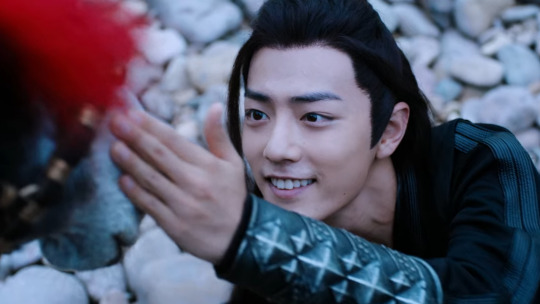
As soon as he has this realization, Apple comes back from roaming around, and never gives him any trouble after this for the rest of the story. Which...probably doesn’t mean anything.
Wen Gravesite
Does Wen Ning hang out here because it’s where he and his (dead) people came from? Oh great, now I am sad.
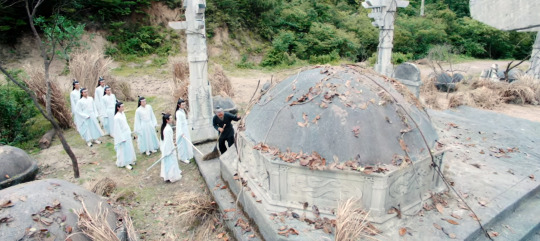
Judging by all the leaves on this grave thingy I’m going to say that this grave tender dude is, ah, not very good at his job.
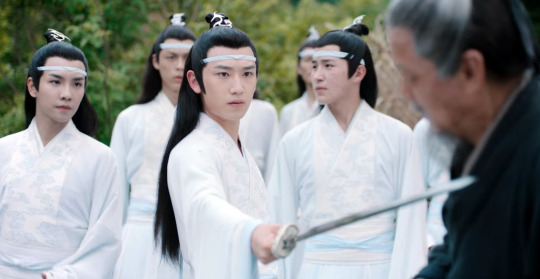
Get him, Jingyi!
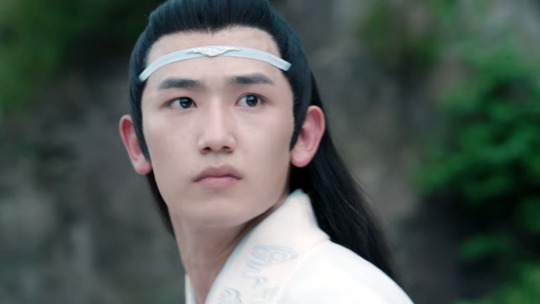
I feel like maybe we all focus too much on how Lan Jingyi is so hilarious and sardonic and not enough on how he is a such a biscuit.
Soul Grass

As mentioned in the previous post, Chinese spiritual concepts don’t always translate well into English. Soul grass? Sure, why not.
This is where Wei Wuxian’s Sherlock Holmes brain starts to work, although he still doesn’t remember really basic stuff about Dafan Mountain. Dying and changing bodies is rough on the old neurochemistry. This creates more opportunities for flashbacks, however, and if there’s one thing The Untamed deffo needs more of, it’s kissing flashbacks.
Temple Statue
Presumably grave-tender dude is also in charge of clearing away spiderwebs at the temple, because it’s not getting done.
Jin Ling walks into the temple blaspheming at full volume.
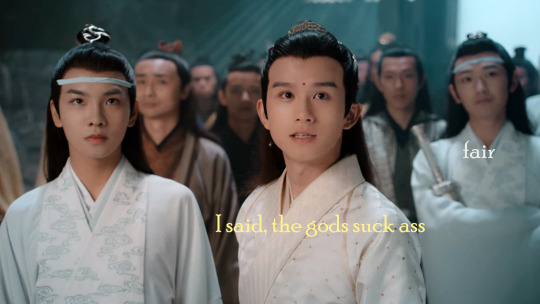
Since this isn’t a Greek story, he isn’t immediately struck blind for this. Then when he wishes for the statue to come alive, it obligingly does. Everything’s coming up Rulan!

Wei Wuxian shows up to rescue all the kids by throwing talismans at the monster which does not tip anyone off to who he is.
Baby Cultivator Babysitting
Lan Wangji chills out in the cultivators’ pavilion with Jiang Cheng and their mutual hate boners.
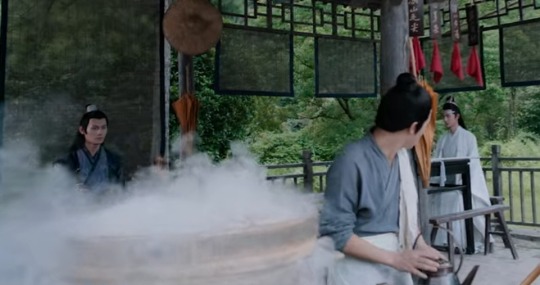
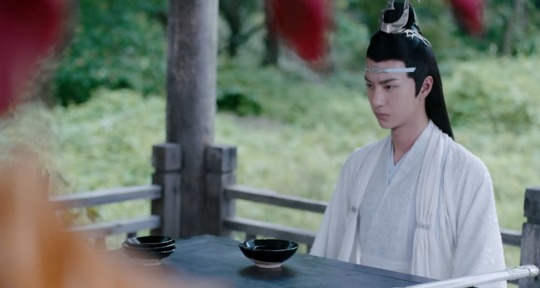
Meanwhile, Wei Wuxian forgets all about his nephew and turns into cool professor guy, explaining the basics of soul-eating to the baby cultivators and gleefully encouraging their fear of Hanguang-Jun’s punishments.
Because the Lan babies are good filial children they are super respectful and engaged with this random adult who is lecturing them. They also - like their own Hanguang-Jun at their age - see and admire Wei Wuxian’s intellect. It’s easy to forget how extremely smart Wei Wuxian is, because of how extremely dumb Wei Wuxian is.
Lan Jingyi suddenly figures out Wei Wuxian is not crazy.
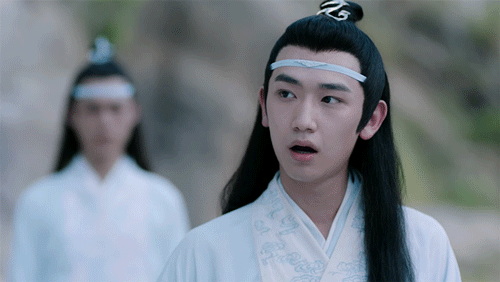
Bis. Kit.
Then Rock Lady shows up and Jin Ling sticks 6 arrows into her while Lans Jingyi and Sizhui stand around not bothering to draw their swords.
I see a lot of comments about the bad effects in the statue sequences but I think Rock Lady is all right. The figure animation is decent and the lighting is no worse on her than on everything else in the scene. Her hair is nice, for a rock person.
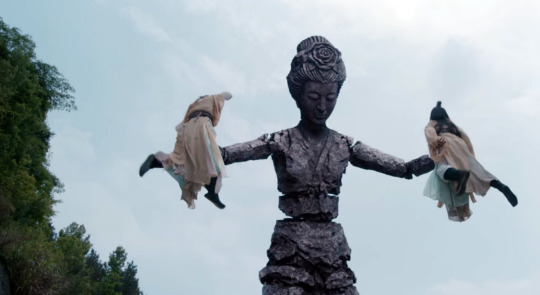
Admittedly I just finished watching Guardian which has CGI monsters so bad they may have injured my retinas and possibly also my DNA, so the bar, for me, is pretty low. Rock lady clears it with room to spare.
Note: Wei Wuxian’s flute playing does zippity towards controlling the statue. Not sure what his plan was here.
Wen Ning Kicks Ass
Now we get to meet Wen Ning, who appears to be a stone-cold badass. Later we will discover how hilariously inaccurate that assessment is.

While all versions of Wen Ning are delightful, this version of Wen Ning is also...strangely attractive? He’s got a Patti-Smith-Horses-Era vibe here, instead of his more usual lost-baby-dork vibe. And his dreamy “I have nails in my head” expression is intriguing.
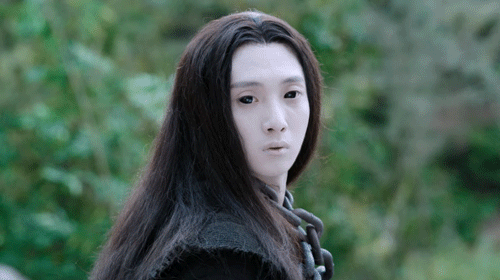
I mean, he’s not a total snack like zombie Song Lan or pre-zombie Song Lan or blind Song Lan or post-zombie Song Lan, but this look is a good one for Wen Ning, is what I’m saying.
Reunions are Awkward, Part 2
Lan Wangji, who has 99% already recognized Wei Wuxian because of the haunted sword and the fierce jawline and beautiful neck and tiny tiny waist, is summoned by his flute playing as inexorably as the Ghost General was.
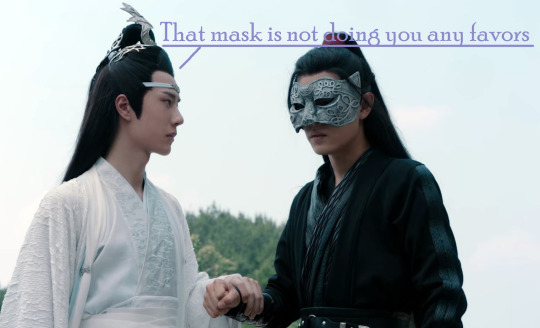
Jiang Cheng also recognizes Wei Wuxian and goes into full beatdown mode, thwarted (silently) by Lan Wangji. Wei Wuxian attempts to preserve his incognito by sassing Jiang Cheng in as sibling-like a manner as possible.
Hanguang-Jun’s Pro-Ghost Agenda Has Been Clear for Some Time
This Jiang/Lan fight is hilarious when you consider the implications.

Macroexpression vs. Microexpression
Mo Xuanyu brought Wei Wuxian back using sacrifice summons, a dark ritual invented by Wei Wuxian that he, most likely, did NOT show to Lan Wangji back in the day. So it’s a pretty safe bet that Lan Wangji doesn’t know that Wei Wuxian was gifted a body, rather than stealing one.

when your brother turns around, you must whip him you will never live it down unless you whip him
When Jiang Cheng lets loose with Zidian, it’s not just because he’s angry. He’s using purple power to force Wei Wuxian’s ghost out of the body he’s apparently possessed. And Lan Wangji instantly STOPS him from doing that.
Clan Leader Jiang: this person has been possessed, against their will, by an evil ghost
Future Chief Cultivator Lan: Counterpoint: I am banging the ghost
Flashback Time
Welcome to your 30-episode flashback!

Once I used to join in Every boy and girl was my friend Now there's revolution, but they don't know What they're fighting
Let us close our eyes Outside their lives go on much faster Oh, we won't give in We'll keep living in the past
Road Tripping to Summer School
Gosh I’m looking forward to younger, kinder, more relatable Jiang Cheng.
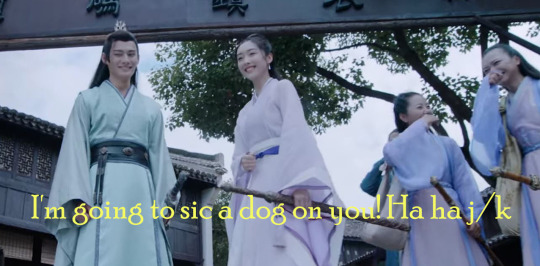
...prick.
Incidentally, until now this episode didn’t know that Jiang Cheng has smile muscles, and neither did the person who glued his wig on for him.
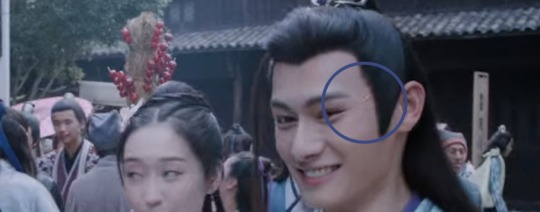
I Like Rabbits
Here we have our first rabbit in a large collection of rabbit iconography that appears in The Untamed.

Instead of sending everyone to the Wikipedia page for Tu'er Shen I’m going to take this opportunity to rec the short film Kiss of the Rabbit God by Andrew Thomas Huang (tw: blood, tw:body-mod cutting) which you can read about and watch over at Nowness.com

Particularly if you are a queer person of Chinese heritage, check it out.
So. What the fuck are these? Are they food?
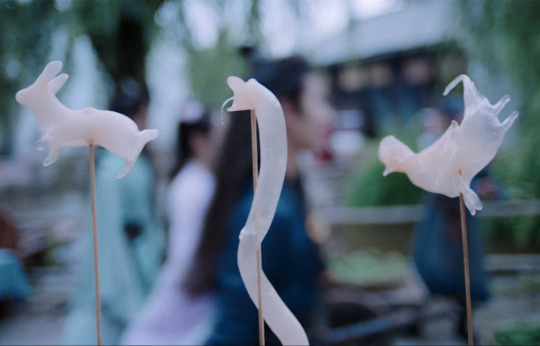
Are they made from wax? Or corn starch? or pig intestines?
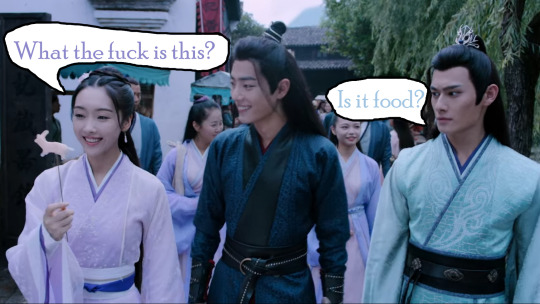
Wei Wuxian runs off to get laid drunk and Jiang Cheng grumps about it. Jiang Yanli reminds him that being free is a Jiang Clan Rule, so really Wei Wuxian is following the rules by not following the rules. Does that mean he’s not free? My head hurts.
Jiang Cheng: yes but grump grump grump
Jiang Yanli: Nothing bad will ever happen because of A-Xian’s choices, trust me
Outro
Wei Wuxian faint tally: one Caught by: the cold hard ground
Soundtrack: 1. Donkey Riding by Great Big Sea 2. Living in the Past by Jethro Tull 3. Whip It by Devo
Fic prompt: Lan Wangji’s internal monologue while he sits in the pavilion with Jiang Cheng
If you write a fic from this prompt and want to share, please post a link in comments!
Bonus: Wang Zuocheng, macro-expression king
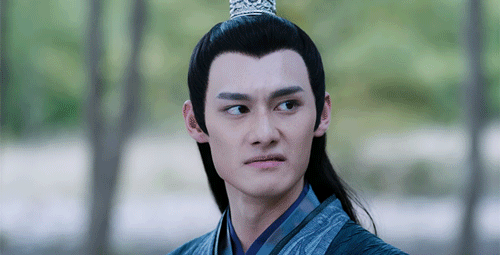
Episode 03 Restless Rewatch coming soon!
#the untamed#fytheuntamed#the untamed spoilers#the untamed gifs#the untamed stills#my gifs#my stills#restless rewatch#restless rewatch the untamed#canary3d-original#wei wuxian#jiang cheng#lan wangji#lan jingyi#c-drama#bl drama#the untamed memes
566 notes
·
View notes
Text
youtube
“Magical,” by Laura Mvula from Pink Noise
A curious millennial once asked me what the 1980s really was like, and immediately I opened my mouth to prattle on about the magic of Michael Jackson and Prince, or about the kaleidoscopic glare of bright jackets caught in the neon lights, or the movie and television screens inflating entertainment personalities into immortal superstars. However, the more I truly contemplated the question, the more I realised that the eighties only resembled those moments in palpable bursts during electric peaks, and I realised furthermore that my bronzed memories from then were couched in far more peaceful, pastoral years and sounds than the garish swash in the background of marketed 1980s iconography lets on nowadays.
Compared to the non-stop pace of today's internet age, life in those days was slower, the rush towards new technology allayed by a clash against long-standing values, I mean the whole place was just imbued with religious commands, symbols, or sayings.
And across that slow tension, your eyesight was just more tessellated with the textures of decades prior.
Everywhere you looked there were people, still wearing clothing from the seventies, getting into Datsuns from the sixties where their AM radio stations played Sam Cooke songs from the fifties. Memes and dances from commercials and sitcoms stuck around for years not weeks and, because of the lack of constant connectivity, the very real fear of nuclear annihilation wasn't even as pervasive as our modern concerns about terrorism or pandemics.
Artists nowadays have tried to capture the feel of the cultural memory of that aesthetic-rich decade in their albums, to just slip it on them sleek like a jacket, most notably Taylor Swift with 1989 from 2014, The Weeknd’s After Hours, from last year, and Coldplay’s Peter Gabriel-esque pep on their recent Music of the Spheres album. Overall, they leaned heavily on the industrial neon glare and synths of the decade, and less on the spaces in between, where we all would take a collective breather.
Each of those albums accomplished the aesthetic goals they attempted, and they draped their best songs in that approach. Looking back now, through the narrow yet fertile valley of memory, I can see that the context, or the width of a culture, is as important as it’s heights. And so, for a more catholic representation of that storied decade, I'd point towards Birmingham, UK singer-songwriter Laura Mvula's latest album Pink Noise.
Mvula's 2013 debut Sing to the Moon, (reviewed here) was a tender beauty of an album, floating on a cloud of choral harmonies, horns and solemn pianos. Her songs there dealt with self-determination, the searching for purpose, and the gentle embrace of love. Her follow-up, 2016s The Dreaming Room, while less focused, continued her musical back-drop of floating harmonies, nocturnal chord changes punctuated by danceable songs of encouragement and heartbreak, helped along in that regard by legendary producer Nile Rodgers on "Phenomenal Woman." With Pink Noise, Mvula changes this approach, tempering her wistful, searching harmonies, and buttoning down the lyrics of her wandering songs of love into punchy, clear-eyed synth pop and r&b. This risk is rewarding for the most part.
“Church Girl” grooves with a stinging snare, harmonies that sway with and against each other, garnished with synth sparkles on the chorus. It’s a swaying, entertaining update of Who’s Zooming Who-era Aretha Franklin, with Laura ensconced in wonderment and concern in the middle of the dance floor, asking, about a love or maybe the music industry itself, "how can you dance, with the devil on your back?/ how can you move? Caught up in a picture perfect that will never last?” Meanwhile, closer “Before the Dawn" is an encouraging anthem that switches between two tempos and moods of electric pop, at one point recalling the high-powered synths of Lionel Richie and Cameo, and then gearing down into the strutting encouragement of a Chaka Khan ballad, all in four or so minutes.
Producers Dann Hume and Troy Miller excel at transitioning Mvula’s songs and swirling lines into these nostalgic textures. The song most reminiscent of her debut, “Golden Ashes,” is layered in sparkled synth notes attempting to balance the Mvulian minor chords. The song would have brightened up The Dreaming Room, but here it is a sleeping album track, indicating true growth is taking place instead of plastic cosplay. The song softens the middle section of the album, along with "Remedy," with its percussive synth lines, and soft chorus in the middle.
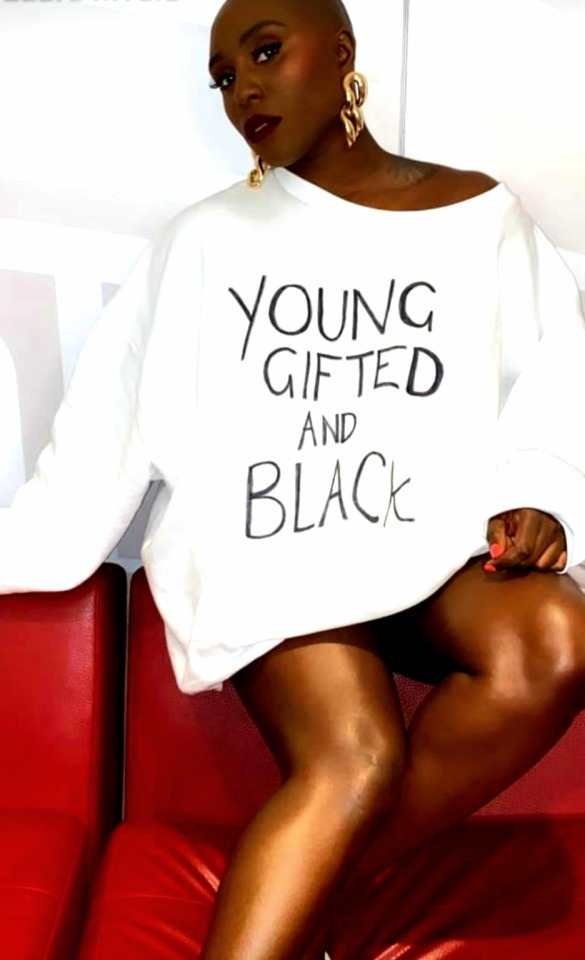
Notably though, these songs do not distract, because the interesting and socially conscious lyrics are caught in the type of synth romp that, upon reflection, typified most songs of the eighties. You see, what plays on digital stream playlists nowadays are the starting lineup of that decade, but the vast musical soundscape of the eighties consisted of songs like these. The album tracks on Wham!, New Edition albums or the myriad movie soundtracks of the era will produce the same musical template.
Meaning, what the sound of the eighties really sounded like, was a menage of late seventies disco hits, Pop vocal power ballads, Reggae lover's rock, Rock hits, and these new wave synth pop dancing songs. There were a bunch of songs that didn’t need to knock it into the stands every time, they just took their time, and found their rhythm.
While there was less neon exuberance playing than the present-day nostalgia of the eighties leads you to believe, there still was an aesthetic of ‘new' in a lot of the media, packaging designs and culture, so I believe that the true feeling of that strange, singular decade was mostly expressed in the synth-laden ballads of Luther Vandross, Atlantic Starr, or Evelyn “Champagne” King that replaced the lush, dense quiet storm staples from seventies soul singers Smokey Robinson and Teddy Pendergrass. That electric sentimentality that came from the throats of everyone's sisters, younger aunties and girlfriends.
It is for that reason that Pink Noise's true highlight is not only the high powered swing of the impressive single "Got Me," but also the towering ballad "Magical." The song finds Mvula trying to mend a frayed romance by utilising the best motifs of the eighties -chucking rhythm guitars, timpanis rolling into the chorus, ponderous synth squats, and a chorus billowed by naked sentimentality, with bright trumpets appearing at the end, played with pomp and alacrity. The song brightens the back end of the album with a steady glow, flourishing character into Pink Noise, the hot midday sister to the furtive, nocturnal Sing to the Moon.
So then the eighties, the eighties. The truth is that thankfully there was less self-aware irony and branded sophistication of the self. Less emphasis on being seen and more on what you were seeing. So much so that you didn’t know the eighties was a thing until the moonwalk. You didn’t know it was over until the Cosby Show was winding down and NWA burst through from someplace called Compton. Mvula easily reminds me though, that there once really was this electric groove snaking high and low amongst the church bells and birdsong and the silence. It was coming out of our cars and homes all hot and new, just out there softly couching our memories.
7 notes
·
View notes
Text
Movie Review | Mulholland Drive (Lynch, 2001)

This review contains spoilers.
David Lynch's Mulholland Drive was released in recent years by the Criterion Collection, that great home video company that's probably the OG of boutique labels, known for putting out acclaimed, significant or otherwise interesting films in really nice packages. (For some reason I had been thinking they put this out only last year until I actually looked it up. I guess my sense of time has been a little warped as of late, and as much as I'd like to tie this review into pandemic-era life, the fact is other labels have captured my attention lately, as can be evidenced by my embarrassingly large and extremely shameful Vinegar Syndrome haul from their Halfway to Black Friday sale from a few months ago.) Now, nobody in 2021 is going into this movie truly blind, but if I happened to pick up the Criterion cover and perused the back, aside from the list of special features and disc specs, you'd see the below (which I grabbed off their website):
Blonde Betty Elms (Naomi Watts) has only just arrived in Hollywood to become a movie star when she meets an enigmatic brunette with amnesia (Laura Harring). Meanwhile, as the two set off to solve the second woman’s identity, filmmaker Adam Kesher (Justin Theroux) runs into ominous trouble while casting his latest project. David Lynch’s seductive and scary vision of Los Angeles’s dream factory is one of the true masterpieces of the new millennium, a tale of love, jealousy, and revenge like no other.
Now, this is a tough movie to evoke with only a blurb, but I'd say that does a pretty respectable job. I however do not own this release. What I do own is the barebones Universal DVD that was released a few months after the movie, back when going into the movie blind would have been far more likely. This is the description on the back:
This sexy thriller has been acclaimed as one of the year's best films. Two beautiful women are caught up in a lethally twisted mystery - and ensnared in an equally dangerous web of erotic passion. "There's nothing like this baby anywhere! This sinful pleasure is a fresh triumph for Lynch, and one of the best films of the year. Visionary daring, swooning eroticism and colors that pop like a whore's lip gloss!" says Rolling Stone's Peter Travers. "See it… then see it again!" (Time Out New York)
Now, the previous description probably couldn't fully capture the movie's essence, but this one makes it sound like an erotic thriller. (Could you imagine somebody going into this thinking this was like a Gregory Dark joint? I say this having seen none of his thrillers and only his hardcore movies, although I must admit an MTV-influenced Mulholland Drive starring, say, Lois Ayres is something I find extremely intriguing.) But you know what? Good for them. Among other things, this movie, with its two all-timer sex scenes, feels like one of the last hurrahs from an era when mainstream American movies could be unabashedly horny, before we were sentenced to an endless barrage of immaculately muscular bodies in spandex (stupid sexy Flanders) somehow drained of all sex appeal (god forbid somebody pop a boner...or ladyboner, let's be egalitarian here). I apologize if I'm coming off as a little gross, but having been able to barely leave the house for practically a year and a half, watching sexy movies like this is one of the few remaining thrills at my disposal. Please, this is all I have.
Now I suppose I should say something about the movie itself, but it might be a challenge given how elusive it is in certain respects (Lynch is notoriously cagey about offering interpretations of his movies) and, as a result, how heavily it's been scrutinized over the years. No doubt any analysis I offer as to the movie's overarching meaning will come off extremely dumbassed. What I will note however, is that for whatever reason, the scene I remembered most vividly is where Justin Theroux walks in on his wife with Billy Ray Cyrus, particularly the candy pink paint he dumps on her jewellery as revenge. We've been following Theroux, a movie director, as he's been having a terrible, horrible, no good, very bad day, having had control over casting his lead actress taken from him, which he proceeds to process by taking a golf club to a windshield of his producers' car and then reacting as above when he finds his wife with the singer of "Achy Breaky Heart".
With his Dune having been notoriously tampered with by producers, I suspect there's a bit of Lynch's own experience in the scene with the producers, which plays like an entirely arbitrary set of rituals deciding the fate of his movie with no regard for his opinion or even basic logic. While I don't know how particular Dino DeLaurentiis was about his espresso, I did laugh. Now, taking the reading that the first two acts of the movie are a fantasy of Naomi Watts' character, who is revealed to be miserable and ridden with jealousy in the third act, the amount of time we spend with Theroux is maybe hard to justify. Is this perhaps her "revenge" on him, his romantic and professional success having been flushed away while he flounders in search of greater meaning to his arc? Aside from possible autobiographical interest, these scenes do play like a riff on the idea that everyone is the main character in their own story, and if the Watts and Laura Harring characters can be thought of as having merged or swap identities, then perhaps Theroux's arc is the remainder of that quotient. (Now, it's worth noting that aside from being insecure and arrogant, Theroux in this movie is a less stylish than the real Lynch. If Watts conjures the best version of herself in her dream, Lynch maybe doesn't want his dream avatar outshining him.)
Now why did the Cyrus scene stick with me all these years when other details had slipped? Mostly because I'd found it amusing, partly because of the extra specific image Lynch produces, and somewhat because of the casting of Billy Ray Cyrus. Now, I don't have any special relationship to the Cyrus' body of work, but Lynch's casting of him, with his distinct mix of bozo, dudebro and hunk, results in a very specific comedic effect. This is something Lynch does elsewhere in the movie, like when he has Robert Forster show up as a detective for a single scene. The Forster role is likely in part a leftover from the movie's origins as a TV pilot, but the effect is similar (albeit less comedic). Melissa George appears as a woman who may or may not be a replacement for Watts in some realm of reality. Other directors obviously cast actors for their screen presence and the audience's relationship to their career, but the way Lynch does it feels particularly pointed, as if he's reshaping them entirely into iconography. The effect is particularly sinister with the presence of Michael J. Anderson, with whom he worked previously on Twin Peaks, and Monty Montgomery as a mysterious cowboy who dangles the secret of the movie over Theroux's character.
Cowboys in movies are frequently heroic presences (see any number of westerns) and are otherwise innocuously stylish (I confess I've come dangerously close to ordering a Stetson hat and a pair of cowboy boots), but the presence of one here feels like a ripple in the movie's reality. A dreamy, brightly lit mystery set in Los Angeles should have no place for a cowboy. It ain't right. (It's worth noting that Lynch at one point copped to admiring Ronald Reagan for reminding him of a cowboy. Is this his expression of a changed opinion? I have no idea, but Lynch has never struck me as all that politically minded.) Neither is the hobo that appears behind the diner. Certainly hobos have made their homes behind diners, but this one's presence and the way Lynch produces him feel again like a ripple in the the movie's narrative. Jump scares are frequently knocked for being lazy and cheap devices to generate shocks, but the one here gets under your skin.
Now about the movie's look. This starts off like a noir, and the mystery plot on paper would lead you to think that's how the whole movie plays, but the cinematography is a lot brighter, with almost confection-like colours, than that would lead you to believe, at least during the daytime scenes. This is another element that likely comes from its TV origins, but it does give the movie a distinctly dreamlike, fantastical quality that a more overtly cinematic look, like the one Lynch used in Lost Highway a few years earlier, might not capture. This is one of the reasons I think this movie works better than that one, and there's also the fact that the amateur sleuthing that drives the bulk of the plot here serves as a more pleasing audience vantage point than the male anxieties that fuel the other film. I also would much rather hang out with Naomi Watts and Laura Harring than a charisma void like Balthazar Getty.
The manufactured warmth of the daytime scenes also results, like in Blue Velvet, in the nighttime scenes feeling like they're in a completely different setting, one which perhaps offers the key to unlocking the mystery, or at least revealing the phoniness of the movie's surfaces. I think of the evocative Club Silencio sequence, which comes as close as anything in the movie to laying its illusions bare. ("No hay banda.") But at times Lynch will throw in disarmingly childlike, inexplicable imagery, like the dancing couples against a purple screen in the opening, something that would seem tacky and amateurish elsewhere but feels oddly cohesive here. There are a number of directors whose work I admire for being "dreamlike", and putting them side by side they all feel quite distinct (you would never mistake a Lucio Fulci film for a Lynch), but they have the unifying idea of imbuing the tactile qualities of film with the truly irrational to really burrow into your subconscious. Other directors have made movies with some of the same elements as Mulholland Drive, but none have put them together in quite the same way.
11 notes
·
View notes
Photo

I’ve also decided to finish this decade with something more light-hearted, detailing the many trends that one can associate with the past ten years. I styled this picture in a similar fashion to those gaudy collages you have relating to the 1980s and 1990s, with this mainly being reflected in the style of this picture. The title of the picture holds a very minimalist design, and is shown from inside a phone, whilst the rest of the poster has a dull white background. These main design choices were added to reflect the omnipresence of smartphones in this decade, as well as the general trend of Minimalism, which has been followed by many companies in recent years. The decision to make the background seem plain was not completely because I’m feeling lazy, but because I tried to follow the trend of minimalism, a trend I personally hate because of how boring it is (I probably would have added in a pretty pattern if there was some other major design trend).
Beyond this though, there are a few other things I chose to add in to reflect the 2010s:
-Ragecomics- The basis of most early-2010s memes.
-Skrillex (or rather Dubstep in general)- A key figure in a genre of music that you either loved or hated.
-Obama- A fantastic President who laid the groundwork for change that will hopefully be built upon in the future.
-Hipster culture- Fresh-out-of-college rich kids who made avoiding the mainstream a mainstream trend.
-The Occupy Movement (“We are the 99%” sign)- A promising post-Great Recession movement with disappointing results.
Gay Rights- Gay marriage is now legal in places like the United States, and homosexuality is more accepted the western world, so much so that companies are now no-longer afraid to pander to them whenever June comes around. Still, other parts of the planet have yet to change their outdated ways.
Trans rights- With people like Caitlyn Jenner and Leelah Alcorn, Transgenderism has arrived into the forefront of social issues, though it remains a strongly divisive issue throughout the decade.
Drones- Like helicopters but smaller and cheaper.
Overwatch- An interesting game that offered a unique personality to the shooter genre in a decade oversaturated with annual Call of Duty releases.
Cuphead- A challenging run-and-gun platformer with a Golden-Age animation-style, showcasing what can be made through video games these days.
Minecraft- The game that doesn’t die. It defined the childhoods of many gamers who fondly remember the early-2010s, and has since made a major resurgence in the decade’s end.
Steven Universe- A much-loved show that offered many unique and progressive themes, which I can admire despite my mixed feeling for the show itself.
Gravity Falls- A show aimed at children didn’t have to be this immersive and interesting, but Alex Hirsch and his team did it anyway and offered the world two seasons of hilarious and yet gripping television.
Political correctness/Woke-ness (“That’s Offensive” speech bubble)- Something that has been pushed to death among the political mainstream, but especially by the Left, as people are silenced whilst others demand safe spaces to keep their precious feelings from being hurt. Political correctness is a somewhat-trend that is better off staying in this decade.
Shrek- Whilst the 2010s have been starved of a new Shrek film besides the contested “Shrek Forever After”, the “Shrek is Love, Shrek is Life” greentext story, despite its crude subject matter, has made the brutish but kind ogre a mainstay in meme culture, whilst offering people the opportunity to explore the nuances of the franchise, after growing up with the character.
Pewdiepie- Starting out strong in the decade, making a name for himself as “that funny Swedish guy who screams as scary games”, an incident in February 2017, in which he was called a Nazi by the mainstream media, resulted in him becoming a more independent and politically incorrect figure, before going on to unite the internet in a battle for the most subscribed YouTube channel against a corporation. He lost in the end, but it was fun while it lasted.
Tyler, the Creator- Offering a unique sound among waves of forgettable Pop music, Tyler evolved from an edgy but somewhat humorous rapper, to an interesting and poignant singer in this past decade, achieving near-mainstream success.
Marvel Cinematic Universe (Endgame logo)- Many mainstream cinemagoers are bound to have seen at least one of these groundbreaking movies in cinemas, with their intense action and perfectly balanced humour, all culminating in the outstanding films “Avengers: Infinity War” and “Avengers: Endgame”.
Death Grips- Unlike anything that has ever been popular among general audiences, the exciting tunes concocted by MC Ride and Zach Hill have remained in the minds of many younger and more alternative individuals.
My Little Pony: Friendship is Magic- Arguably the most unlikely of fanbases to come around in this decade, this re-imagining of an 80s cartoon series had a style of humour and storytelling that peaked the interests of a group of adult men known as “Bronies”, who’s reasons for being interested were questioned and much of the internet hated them, but they were certainly something to behold throughout these years.
The 2016 Presidential Election (Hilary Clinton and Donald Trump)- A time many can regard as the branching-off point between the first and second halves of the decade, as the extremes of both sides were exposed to the world with astonishing results.
Vine- A social media platform that has since disappeared off the face of the Earth, but brought about many notable celebrities and memes that are often remembered by younger generations.
Vaporwave- Alongside Hipsters, Vaporwave was perhaps one of the few examples of a concrete “counter-culture” movement, offering an anti-Capitalist message within its use of music and iconography from the 1980s and 1990s. Since then, it is best known for offering a warm and interesting “aesthetic”.
Pepe the Frog- A frog best known for saying “Feels Good Man” earlier on, was later used by certain Right-wingers and has since been touted as a symbol of hat. But, with a smug grin like that, it appears that he doesn’t seem to care about what others say.
Social media- It already played a massive role from the mid-2000s-onwards, but now, the scale of social media has grown exponentially, with people moving away from mainstream news and entertainment and instead choosing to get their kicks on Facebook, Instagram, Twitter and YouTube. This focus on gaining the news from social media has held some negative consequences as fake news continues to fool gullible Boomers.
Hyperbeast fashion- In terms of fashion, the Hypebeast is the late-2010s’ version of the Hipster, though unlike Hipsters, who are financially-independent rich kids who make questionable purchasing decisions, Hypebeasts are often preteen/teenagers who suck money out of the credit cards of their rich parents.
Adventure Time- A rather interesting cartoon that started off as a fun show to get high to, but evolved into a gripping epic with an expansive lore and interesting world.
Minions- While they were rather annoying to older viewers following their introduction in the otherwise top-tier film Despicable Me, children and especially 40-something year-old Facebook Mums couldn’t get enough of these wacky tic-tacs.
Brexit- A subject that I, as a Brit, couldn’t seem to get away from in the past few years, as politicians refused to move forward with the people’s decision. But, with the Tory majority in Parliament, as depressing as that sounds, it seems possible that we can finally move on as a country to more important matters.
Vaping (Juul-smoking mouth)- Recovered chain-smokers and rebellious teens have made this trend a popular pastime, though its popularity has waned recently over health concerns.
Doge- Whilst it began as a singular image of a cartoonish-looking Shiba Inu making a weird face, as brightly-coloured Comic Sans surrounds her, this dog has become the subject of many surreal and unique memes, taking on many different forms, solidifying the transformative nature that all memes should strive for.
Hoverboards, Fortnite, Dabbing, and Fidget Spinners (The monstrosity on the bottom-right)- What do a handle-less Segway, a more cartoony (but somewhat better) version of PUBG, a dance based off of post drug-taking sneezes and small bits of metal for Autistic children have in common? They have all ascended to levels of annoying trends that at least some people have had fun with.
Undertale (Sans)- An interesting game that has gained a heavy degree of fame for its interesting themes and interesting characters, some of which have been admired a bit too much by certain teenage girls.
As for my personal experiences of this decade, I can say that, whilst I was born in the early-2000s, I was definitely raised in the 2010s. Much of my memories of the previous decade are rather minimal, and I didn’t follow that many trends considering I only lived on constant repeats of SpongeBob by the start of this decade. Since then, though I have gained many impactful memories from these past few years. Some good, some bad, some great, all of which were a part of growing up. In about two-weeks’ time, I will finally become a legal adult, and shall begin the rest of my life. So, I wish you all well, and hope your Twenties are truly roaring!
21 notes
·
View notes
Photo

𝗔 𝗬𝗲𝗮𝗿 𝗶𝗻 𝗙𝗮𝗶𝘁𝗵, 𝗗𝗮𝘆 𝟱𝟮: 𝗦𝗵𝗶𝘃𝗮
Shiva is one of the most important of all the myriad Hindu deities and the supreme being in the Shaivite tradition. He is a god of destruction, an ascetic yogi, lord of all dancers, and the definitive family man.
𝗟𝗼𝗿𝗱 𝗼𝗳 𝗖𝗼𝗻𝘁𝗿𝗮𝘀𝘁𝘀
Shiva’s nature is built upon contrasting elements, a feature that likely stems from his Vedic origins. In the oldest layers of the Vedas, themselves the oldest of Hindu scriptures and the oldest Indo-European language texts, the word “Shiva” appears only as an adjective meaning “auspicious”. This adjective is notably used as an epithet for the minor storm god Rudra. In his standard form, Rudra is a fearsome manifestation of the storm, a destroyer of crops and homes. However, in his kindly aspect i.e. Rudra-Shiva, he is the rains that feed crops and thus a source of life. As the deity developed, Shiva became the namesake, with Rudra and other gods becoming aspects of this greater power, but this initial feature as destroyer and creator still defines him. In the Hindu Trinity, he remains the god of destruction as opposed to Brahma’s creation and Vishnu’s preservation, but his destruction is seen as part of the process of continuous creation and rebirth. Another contrasting element is his social life. On one hand, he is an ascetic monk, depicted as isolating himself on mountaintops to meditate, wearing animal skins and letting his hair mat. On the other hand, he has the most established household of any Hindu god and is often depicted with his wife, Parvati, and his children, Kartikeya and Ganesha.
𝗦𝘆𝗺𝗯𝗼𝗹𝗶𝘀𝗺
As may be expected of a deity with a long history and widespread cult, Shiva has a wealth of iconography. Modern Hindu art, especially under the influence of 19th century painter Raji Ravi Varma, has more or less coalesced into a consistent vision, and the following symbols can all be seen in the title card for this post. As an ascetic monk, Shiva wears his hair in Indian style dreadlocks, called Jaṭā. Jaṭā are a sign of the ascetic’s detachment from the world and, like actual ascetics, Shiva wears them loosely coiled on the top of his head. At the peak of these coils is either a lotus or a woman’s face, representing the embodiment of the Ganges river. The common story is that Shiva contains her to only let loose a small stream of her true power (the enormous Ganges river), as otherwise she would flood the world. Also in Shiva’s hair, there is a crescent moon, as Shiva is often credited as the reason behind it’s waning and waxing cycles. On his forehead, Shiva typically depicted with a third eye, or a mark representing it. Though third-eye iconography extends beyond Shiva, he is the god most commonly associated with it, and famously used it to incinerate the god of desire, Kama. Shiva dresses in only a tiger skin, again in part a reference to his ascetic detachment and also to his dominion over animals, sometimes viewed as a metaphor for the dominance of rationalism over instinct. Similarly, a cobra is wrapped around his neck. There are many explanations, most of which boil down to the fact that snakes are dangerous, but only Shiva us the ultimate lord of destruction. Shiva can be posed in one of two ways, representing different aspects of his nature. As the calm and detached ascetic, he is depicted seated in typical Yoga meditation, and as such is the patron of the Yoga tradition (both as philosophy and exercise). As an active destroyer and creator, he is portrayed as “Nataraja”, the “lord of dance”. In this pose he is dynamic, one leg kicked out astride a ring of fire. He carries with him a trident and a drum, sometimes tied together. The trident is a weapon befitting a destroyer and, as will be discussed later in this post, the number three is a recurring theme for Shiva. The drum is an extension of his Nataraja aspect, keeping the beat as he dances. Finally, there is his vehicle, or Vahana, Nandi. Nandi is a white bull, an Indian Zebu to be precise, and serves as the symbol of the Shaivite tradition.
𝗟𝗶𝗻𝗴𝗮𝗺 𝗮𝗻𝗱 𝗢𝘁𝗵𝗲𝗿 𝗜𝗰𝗼𝗻𝘀
Despite the fact that some of the worlds largest statues are of Shiva, he is most typically worshiped in an aniconic form known as the Lingam. For reference, in the art used for the title card of this post, a generic Lingam is placed directly in front of Shiva’s legs. The Lingam is made of two primary parts: the central pillar and the basin. A common interpretation of these represent a combination of a masculine (the phallic pillar) and feminine (the yonic basin) parts, representing the totality of things as well as the act of creation. Though there is little doubt from the historical record that Lingam use sex organs as the basis for their abstract iconography, it should also be noted that they can and are interpreted outside of that context and that perception of the Lingam as purely sexual (as Muslim and Christian conquerors/colonizers have) is about as accurate as perceiving the Christian cross purely as an implement of torture. Lingams come in many sizes and shapes, and date back at least to the 3rd century BCE, with some claiming evidence of even older Lingams. Lingams are often decorated with flowers and have water or milk poured over the central column. The column itself often has a symbol painted or carved into it; three horizontal lines behind a red dot. This is called a Tripundra (literally “three marks”). This is a common sign of Shiva and is often worn on the foreheads of Shaivites. The dot in the center is the third-eye, as mentioned above. The three lines are given much symbolism. They can represent Shiva’s trident, three sounds of the primordial syllable Om (typically divided as A-U-M), the Hindu trinity (of which Shiva is the third), the three realms (heaven, earth, hell), or the three Gunas i.e. fundamental attributes. The Gunas may be one of the better metaphors as, like the stripes of the Tripundra, the Gunas are simply a representation of the world split into three, literally and metaphorically.
Image Credit: J.B. Khanna Pictures, probably from the 1970's or 80's
9 notes
·
View notes
Text

hi i’m nora ( 23. gmt. she/her ) and it turns out i really miss playing bridget ! i wasn’t feeling frida bt i wanted to explore som of her backstory more so ive kind of fused bits of her into bridget..... sue me.... for those of u who didn’t know her before i dropped her, bridget grew up in a trailer park in texas, she’s an angsty socialist leftie who gets fucked at the pub and goes off on one about capitalism. film nerd. got in on a partially subsidised scholarship and works in a bar and a fast food place to pay for her accomodation. here’s a pinboard !! everythin else is below this cut, like this post n i’ll (probably forget to) smash that im button for plots x
application template.
( cis-female ) haven’t seen BRIDGET MATUSIAK around in a while. the MARGARET QUALLEY lookalike has been known to be GARRULOUS & CANDID, but SHE can also be FICKLE & ERRATIC. The 21 year old is a JUNIOR majoring in FILM. I believe they’re living in AUDAX but I popped by earlier and no one answered the door.
aesthetics.
thumb holes poked through the cuffs of your sleeves, roller blades, grazed knees, not eating your greens, smiling with a mouthful of blood, sleeping in a cherry lip balm and scrunchies to keep the wild locks from your eyes. piercing your own ears with a safety pin when your dad wouldn’t take you.
connection to tatiana & did they choose her name during the watershed?
knew each other from the cheer team in bridgets freshman year and tatiana’s sophomore year. had a competitive friendship to start with but then they got into a discussion about politics at a party one night, and maybe hooked up a few times after tatiana had jst broken up w someone. they were sort of seeing each other very casually for a bit, but…. they came from vastly different circles n it didn’t really work. they were in a bad partch at the time of the reaping so to speak, and bridget picked her name For A Giggle but now regrets it big time obviously
tw drugs, teen pregnancy
BACKSTORY TIME.. her mother was from the wrong side of the tracks, was chucked out of home pretty young after a teenage pregnancy, wanted 2 go to art school and started working as an erotic dancer to pay for college but then jst…. ended up staying there. one of those girls u see in the documentaries who had Big Plans but ultimately never got to pursue them n jst got…. sucked in by the money
her mom n dad met in high school at a parents evening. alice was fourteen, toby was thirty-one. bridget’s mom alice was a roman catholic – uneducated in matters of safe sex, mother mary around her neck, bras hanging over wooden crucifixes – and willing to give it to the first boy who seemed interested enough, gift-wrapped or not. toby was the father to a girl down the road who alice knew nothing of besides her name and the few encounters in the corridors facing a stoney stare that screamed homewrecker. it only happened once, but once was enough. alice was out of the house as soon as her parents knew a child was growing in her womb.
bridget n her mum alice were more like sisters growing up, probably because of the closeness in age. alice should’ve known that you couldn’t have a thirteen-year-old-daughter at 27 without everyone knowing you’d been one of those girls who gave it away fast as a hot potato, and maybe bridget should have known that she’d inherit more than her mother’s wide eyes, that things have a way of circling back to us --- that at fourteen she too would lose it on the floor of a swimming pool changing room, soggy back, polka-dot nylon of a swimsuit pulled down to her ankles.
she grew up in a trailer park just outside of orlando resort, but she was raised in dressing rooms surrounded by sparkly costumes and nipple pasties and leotards and the like. as a kid she’d try to trot about in her moms heels n yearned for the day she’d be able to be on stage.
if you’ve seen the florida project its a bit like tht.... just kids left to do their own shit.... mother’s a bit all over the place... made money by stealing wristbands off orlando theme park visitors, and bridget was p much raised by the community, to be honest. most of her youth was spent scurrying about half naked in cowboy boots and glasses too big for her face. a smol feral child
gilly (referred to as junior) was born four years after bridget, the son of a carpenter and sculpture artist named gilbert “gilly” senior, her moms latest squeeze. whenever she wasn’t at school bridget would be in gilly’s workshop doin her homework surrounded by parts of furniture or hanging out with the kids who were visiting disneyland but couldn’t afford the hotels on the resort
like her mother, bridget fell pregnant barely out of her gingham print dresses, hair in two plaits down her back, teddies still lining her bed. unlike her mum, she was not box-shipped out to a home for fallen women but rather booked into a clinic, given a pill, just like taking your vitamins.
her mother flaked out when bridget was around fifteen and junior was eleven. they were in the system for a while, before gilly was finally granted custody as legal guardian. the three of them moved to marfa, texas so that gilly could run classes in sculpture and woodworking at the art institute. they’re not sure where their mother went. some say she rededicated herself as a virgin and joined the convent in penance for her sins. some say she works in a las vegas strip club and sells pills to minors. bridget likes to believe that she’s an actress, her name in newspapers and her face in a star-spangled dressing mirror.
bridget used to do sponsored silences and hunger strikes for kids in developing countries. was that kid in school who was always raising money something. i mean its kinda cute but also she just wanted the acclaim and attention so…. and most of the time it didn’t even make it to the disadvantaged kids she was raising it for cos her mom needed rent money or to buy the kids new shoes n they could barely afford much themselves
she’s a strident feminist, an activist for human rights and animal rights, a vocal vegetarian and an all-round soapbox sadie. catch her in the quad shouting about human rights through a megaphone. will most definitely have quizzed your character on institutionalised racism whilst inhaling nos at a party and snacking on a big bowl of cheesy wotsits
aesthetic: big military or leather jackets over tiny little sundresses. always in docs or creepers and a beret with an anarchist symbol painted on it. wears a long green trench coat covered in badges for alt punk rock bands or a red denim jacket that she hacked into a crop jacket with a pair of kitchen scissors. cuffed jeans, thrifted or stolen. white converse, more grey tbh through years of wear. crop tops and plaid shirts tied round her waist. smudged mascara. glitter smeared over cheekbones from the previous night. cigarette smoke shrouding you like a veil, the red string of a thong peaking out purposely from jeans, piercing your own ears with a safety pin when your dad wouldn’t take you, kate moss posters lining the walls of a teenage bedroom, thumb holes poked through the cuffs of your sleeves, feet pounding the earth until your soles bleed crimson.
an aspiring screenwriter. she has a very image-based view of memory and experience. always doing a screenplay or shooting film. her style has a lot of catholic iconography (think virgin suicides style or baz luhrmann’s romeo + juliet if it was done on a super 8 camera) bcos catholicism is one of the few things she remembers about her mother. she’s never actually tried to find her mum / find out about her, jst…. occasionally channels that energy into her work.
struggles with self-image and the need to be Loved By All a lot. uses sex as an affirmation of her worth and also kinda manic-depressive (though not officially diagnosed) bcos her upbringing was a bit unstable, she was a looked after child for a while when the adoption papers were still going through… struggles a lot with feeling unwanted, especially since her grandparents refuse to acknowledge her existence cos she was born outside of marriage….. so she craves feeling wanted,, like despite being a real women’s rights activist and hating objectification, at the same time to bridge there’s nothing better than someone sizing you up with hunger in their eyes
she’s queer, but i guess she favours women, and is incredibly vocal in her support of the lgbt+ movement. often at rallies. has done a face-sitting protest. really is that bitch
there’s a degree of anger for anger’s sake in bridget. she likes passionate, angry music – particularly garage rock, punk and riot grrrl. she loves the slits and skinny girl diet. viv albertine inspired her to take up bass guitar.
back at lockwood she was working two jobs to pay for uni !! at the bowling alley polishing the shoes and fixing the bowling lanes, and also as a burger flipper at mcdonalds. in amsterdam she’s managed to secure a part-time bar job at one of the hendrix university bars
massive film buff. is majoring in film at uni also spends a lot of time at the movie theatre n probably has like a season ticket. is one of those pretentious film nerds who’re like “what do u think of goddard’s work?” but also just really into shitty horror movies
she spends her evenings in downtown bars willing away her boredom, trying to find something that’ll jerk her out of apathetic lethargy. she toys with the idea of becoming a stripper — it certainly pays better than flipping burgers — but she lacks the energy to dance for several hours a night.
she loves b movies and slasher flicks. at parties, she’ll occasionally try to make a horror of her own, on a super 8 camera in someone’s basement, very paranormal activity, but she’ll inevitably get bored, or too drunk and give up, like she does with most things in her life. she lacks drive and motivation. she’s bright but there’s no hunger in her.
she’s fickle and enigmatic. one moment she could be your best friend, the next, she’ll behave like a total stranger. bridget’s unpredictable because she’s still unsure of her own identity, frequently flitting between different characters, like snake skins, before she grows bored of being bubbly and eager and becomes spiteful again. her core personality traits are probably forthright, impulsive, restless, thrill-seeking, selfish, gregarious, easily bored, childish.
SOME ?MILDLY AMUSING? FACTS
writes shitty poems on the back of napkins and quotes dead philosophers she’s never read. romanticises herself a lot. like will be standing there in a ripped t-shirt and her undies smoking a cig like “hmmm… i bet someone is falling in love with me right now”
is vegetarian for environmental reasons but snorts coke at parties like that isn’t shit for the environment ?? sis, it don’t add up
loves dirt. ate a worm once because someone dared her too. shamelessly disgusting.
she’s slightly obsessed with true crime, up late watching documentaries on the manson family murders.
favourite drink is cherry coke
a lot of her time is spent in the record store, plugged into a set of headphones, head-banging in the corner to a scratched record. music, for birdie, is a form of escapism. that and dropping acid in parking lots lmao.
sells nudes on twitter. whenever she gets low on cash she contacts one of the seedy old men who used to visit her mom’s club to venmo her $500 in return for pictures
that girl who’s always harping on about body positivity on instagram while wearing cute underwear and looking absolutely bomb
really good at rodeo bull riding. the club in marfa had one so as a youth she got really good at it bcos she was constantly tryin to outdo her friends on who could stay on for the longest. a video of her staying on one for like 4 minutes after downing several jager bombs went viral once.
micro-doses acid for mild depression bcos she didn’t believe in “that CBT bullshit”, thought that therapists, like her, were jst con artists so always a bit spaced out
volunteers at one of the local galleries but mostly just rants to old white dutch men about how cis white men have dominated art for years :/ is one of those SJW-types , like.... have a day off, jameela jamil......
has a pet rat called popeye
takes photographs of dead animals to use in her art and often posts them side-by-side with stills of women in porn to show the shelf-life of female sex workers in a patriarchal-dominated industry or some bullshit idk
big into spoken word poetry, even if its shit. likes savage depictions of femininity
wrote a thesis on art as an act of masturbation that got published
this bitch HATES capitalism and LOVES karl marx
time isn’t real. nothing exists. the self is a social construct. finger guns.
an awful person, really
plots i want that i mostly stole from the tags
muse a tries to stand up for muse b in a bar but unfortunately cannot fight for shit.
muse a (prob bridget cos works in a bar) works somewhere that’s open late and muse b comes in to take shelter from the storm.
‘I got in my car and you were sleeping in the backseat who the hell are you and how did you get into my car’
umm a wlw plot isnpired by san junipero ! esp this post. could have been a former fling that ended sourly !! cos i dont like ship forcing but still?? give me wlw stuff
“i just decked you in the face because i’m drunk and you were pissing me off but ow my hand really fucking hurts i think i might have broke it and oh look your nose is bleeding and now we’re both sitting awkwardly in the hospital while i glare at you from across the room. but wait are you giving me sex eyes?? stop that i’m supposed to mad at you??”
“platonically sharing a bed until i wake up and you’re curled round me and my nose is buried in your hair so i’ll pretend to stay asleep to keep this for a little while longer” plots
“highkey want a ‘someone wrote your phone number on the wall of a bathroom in my dorm with ‘call for a good time’ and i just texted you to let you know that i scribbled it out and oh wait you’re actually funny and easy to talk to and now we’re talking every day and i might have a tiny little crush on you even tho i don’t even know your name’ plot”
goddamn its another shippy wlw plot apparently that’s all my tag is but this post
“known for being rebels without cause, MUSE A and MUSE B are synonymous to their fast cars, nights out beneath the stars, empty bottles of alcohol, and loud music. they meet by chance one night and immediately click, and embark on a careless adventure after it despite not knowing each other. it’s them against the world: after all, what could go wrong ?”
any of these sad sour unrequited love plots
‘we take the same elevator every day and due to a misunderstanding I assumed you didn’t speak english and I’ve been talking to my friend about how hot you are for three weeks and apparently my friend has known from the start but you agreed not to tell me bc you both think its hilarious what the fuck’ au
‘I accidentally dropped you while you were crowd surfing and you broke your ankle and now I feel responsible so I’m carrying you out of the moshpit’ au
walked in on my roommate and you screwing except i know you from class and i freaked out a little
i was hustling you in pool for money but you were hustling me for free drinks so who’s the real winner here?
bridgot goes to strip clubs n peep shows like every day, cos she’s writing about the history of pornographic film n its basically research for her, so if ur characters would be into strip clubs they might see her there
i feel like she’d be on student council if they had one of those. shes that kind of bitch, turning up like elle woods with a big feather pen or a light-up heart marker, slamming down some truths before upping and leaving to go for her 11am chai latte break
som1 who attended the art institute in marfa for a summer n maybe knew her when she was a bit younger ??? idk
drama. angst. horror. also nice bike rides in amsterdam please
feel free to im me if u wanna plot, or, like this post and i’ll hit u with a message!
#i have literally just slapped bridget n frida in a blender.#sorry if u had plots with frida. pls feel free 2 discuss w me n we could just do them w one of my other characters instead if it fits.#xxxx plot with me my goblin children xxx#water:intro
15 notes
·
View notes
Text
Donald Glover - Childish Gambino
Childish Gambino — aka actor, director, singer, writer, Donald Glover — has kept the number one spot on the Billboard Hot 100 for two weeks in a row with his recent single "This Is America.". “This is America” is Gambino’s first single since he dropped the 2016 studio album Awaken, My Love!.

"America" takes over the No. 1 spot from Drake’s “Nice for What,” which has ruled the chart for four non consecutive weeks.The song already marked Gambino's first foray into the top 10 of On-Demand Streaming Songs, after his earlier hit “Redbone” peaked at No. 11 (July 1, 2017; 10.8 million on-demand audio streams). Now, “America” has 26.7 million on-demand audio streams earned the week of May 17 -- its first full seven days of tracking -- according to Nielsen Music.
“America” concurrently spends its second week atop Streaming Songs, increasing in overall domestic streams to 69.6 million total, up 7 percent. A total of 61 percent of the song’s overall streams come from video views (down from 68 percent in its release week).
The imagery and iconography in Glover's video has kept culture critics talking since it dropped on May 5. Ongoing political and cultural tumult and turmoil, Childish Gambino’s “This is America” appears to be a commentary on black life in America and American culture as a whole.
In the music video, directed by frequent Gambino collaborator Hiro Murai, Gambino portrays satire of the minstrel tradition and the stalemated gun debate, along with about a dozen other things—it’s daring, provocative, traumatizing, cynical, discomfiting, ultraviolent, implicating, depressingly meme-worthy and some might say genius work.
Glover’s[Bridge: Childish Gambino & Young Thug] We just wanna party Party just for you We just want the money Money just for you (yeah) I know you wanna party Party just for me Girl, you got me dancin' (girl, you got me dancin') Dance and shake the frame (yeah)

It’s main focus is the dancing around with school-aged children gleefully, seemingly unbothered by the chaotic scenes of violence in the background.
Showing the relationship between the dancing and partying and violence that combine to make up so much of both entertainment and black life in America. Donald and a group of school children perform popular dances like the “shoot”and the “Roy Purdy dance,” while other people scatter in the background. Donald and the children remain the focal point, representing how social media blinds people from the true problems in America by feeding them entertainment and pointless trends... This song has caused a lot of people to talk. https://www.youtube.com/watch?v=VYOjWnS4cMY - video. I am sure if you watch you will be shocked or taken back. enjoy. rated r.
6 notes
·
View notes
Video
youtube
"Walkin' on the Sun" was released as the lead-off single from Smash Mouth's 1997 album, Fush Yu Mang. It was also the band's debut single. The single was released on July 18, 1997. Unfortunately, this was another one of those songs that did not receive a commercial single, so it was ineligible to appear on the Billboard Hot 100 due to the chart rules that were in effect at the time. However, the song did manage to peak at number two on both Billboard's Radio Songs chart and on Billboard's Mainstream Top 40 chart.
I was 22 years old when "Walkin' on the Sun" was released as a single. This song grabbed my attention immediately, and I think it was combination of the lyrics and the psychedelic elements that were included with the modern rock sound of the mid-to-late 1990's. And, let's be honest, the song is also just so darned catchy. I still like this song a lot, and it's probably my favorite song by Smash Mouth.
The music video definitely looks like it came out in the mid-to-late 1990's, thanks to the overlit trope that had become so overused at that point. The music video also utilizes a lot of exaggerated wipes, which would become a hallmark for music videos by acts like Smash Mouth. There's also some iconography from the 1960's, such as the scenes when they're dancing out on the beach, as well as the drag race that takes place near the end of the video. And during the beach scenes, I swear there's two or three people that show up in it that make me think of characters from Gilligan's Island. The video has that "exaggerated" look to it that would become a hallmark for Smash Mouth's best-known videos.
0 notes
Video
youtube
RECORD YOU SHOULD BUY IF YOU HAVE TO BUY A RECORD THIS WEEK BUT FOR SOME REASON DON’T WANT TO BUY A BLUE TAPES/X-RAY RECORDS RECORD #55
Madonna - Like A Prayer (Sire Records; 1989)
From The Guardian's Hadley Freeman:
"Any woman my age who claims to have no emotional connection to Like a Prayer is a liar, not my age and quite possibly not a woman. And unlike too many albums to which women are supposed to have emotional connections, this one isn't mopey, self-indulgent, difficult or weird: Like a Prayer is a joyous reminder of just how fun Madonna really did used to be. I was 10 when this album came out and while it wasn't my first modern pop album (that accolade went to the still relevant … Tiffany), it was the one that shaped what I thought, and still think, pop stars, pop music, music videos, love, sex and the 80s were and should be.
It's hard to think of an album cover more evocative of women in the 80s than Like a Prayer, with its juxtaposition of jewels, religious iconography, a bare tummy and high waisted pale denim jeans. This is the ladies' answer to Bruce Springsteen's Born in the USA, replete with denim crotch-area shot. If I'm being totally honest, I still think this is how cool people dress.
Maybe 1989 was a simpler time. Maybe it was just me that was simpler. But I have never since seen anything on MTV as thrilling as that first viewing of Like a Prayer, and yes, I am including any lame video by Kwik-Fit Madonna, Lady Gaga. The obvious courting of controversy (Like a Prayer), the black and white graphics (Express Yourself), the beach-based larks (Cherish): all the best 80s music video tropes captured on one album's videos. (Many a time did I happily think Cherish was about to start on MTV only to realise, grumpily, that it was the similarly ocean-sprayed but deeply tedious Wicked Game by Chris Isaak.)
Not being Catholic, there was no rebellious appeal in the album to me and my parents apparently had no problem with their Jewish daughter watching – if not quite understanding – a music video that featured a woman named Madonna apparently giving a blow job to a black Jesus. I've spent my entire life too busy dancing around and singing the lyrics (incorrectly) to worry that most of my favourite songs are actually about religion (Like a Prayer, You Got the Love.) I'm simply a very shallow person. I like songs that make me dance and make me happy and it just so happens that a song about blowing Jesus has been making me happy for the last two decades.
Although Like a Prayer was not my first album, Madonna was my first music concert. For my 12th birthday I proved my coolness by going with my babysitter to the Blonde Ambition tour and repeatedly expressed bafflement at why people weren't sitting down as I really would have been able to see better. I saw enough. To all parents out there, there is no better way to open your little girl's eyes than packing her off to watch a woman masturbate on stage.
I am always surprised whenever I listen to Like a Prayer how great the songs still sound (which is not something I can say of Tiffany.) Cherish, Express Yourself and Like a Prayer are timelessly euphoric (the key change in Like a Prayer – at 2:38, for the record – still gives me a weird thrill) and still make me sing out loud. Yes, with my headsets on. Yes, on the tube. Yes, to the point that everyone in the carriage moves down to the end that a tramp has been using as a toilet to get away from the tragic woman singing about how, in the midnight hour, I can feel your power.
Keep It Together is amazing, purely for being Madonna's take on Sister Sledge's We Are Family, a concept no one foresaw, and the fact that she later disowned various members of her family gives it, shall we say, an interesting tinge of irony. Pray for Spanish Eyes is, I can say with wisdom attained, excellent singing-in-the-hairbrush fodder as well as being a prime example of Madonna's fondness for pretending to be a tragic historical figure (see also Evita, Wallis Simpson.)
But being a nosey sort and someone who likes songs to have stories, it's the confessional stuff I love most: Oh Father, Promise to Try and, most of all, 'Till Death Do Us Part, about the end of her marriage to Sean Penn, with whom, she has said since, she was deeply in love. The bitterly evocative lyrics ("The bruises they will fade away/ You hit so hard with the things you say/ I will not stay to watch your hate as it grows/ You're not in love with someone else/ You don't even love yourself/ But still, I wish you'd ask me not to go") disprove those who describe her as a cold and blank performer. Even if most of us haven't been married to Penn (thank God), that sentiment – deciding firmly to leave the jerk but wishing dearly he'd ask you not to – is all too universal, and it feels even more extraordinary now to hear Madonna, now untouchably self-controlled, admit to such pain and weakness. But while the song is sad, the music is jaunty, even fun, and about as far away from Joni Mitchell-esque self-pitying noodlings as you can get. This is a break-up song that cheers yet simultaneously consoles. Even Madonna once felt like this. You'll get through it (and hopefully without rebounding with Vanilla Ice.)
The album's one duff point is the duet with Prince, Love Song, which is barely a song, let alone a love one. But even this works in the album's favour because it serves as a reminder of an oft-proven truth: Madonna is always best on her own. This album sums up the best of her: fun to dance to, laughably grandiose, self-revelatory but on her terms.
Unlike many of my friends, I do not have any hangover idolisation of Madonna herself. She personally peaked for me when she humiliated Warren Beatty in In Bed With Madonna. But no matter what she's done to her face, her body and the world of cinema since, she will always be the woman who introduced me to MTV, pale denim and masturbation. And for that, I thank her."
Buy here.
2 notes
·
View notes
Text
Game of Thrones: House of the Dragon is a Familiar Choice
https://ift.tt/34gU7Uy
Game of Thrones prequel House of the Dragon focuses on the "Dance of Dragons" civil war between Targaryens. We consider why HBO picked it.
facebook
twitter
tumblr
As you’ve likely heard by now, Jane Goldman’s Game of Thrones prequel, tentatively titled “The Long Night,” is dead, and Ryan Condal’s Game of Thrones prequel, House of the Dragon, is going straight to series. Long live the Game of Thrones prequel. This news was met with much fanfare by WarnerMedia, who made it the crown jewel of its HBO Max presentation. The series, which is getting a full 10-episode order out of the gate, will pull liberally from George R.R. Martin’s Fire & Blood and dive deep into the history of House Targaryen.
These tidings have traveled across the internet faster than news of Jon Snow’s true parentage. And yet, what it means is only beginning to be grasped, as is perhaps why HBO elected this to be its first Game of Thrones spinoff to see airwaves and streaming after putting at least six pilot pitches into development. What news has thus far been unspooled about House of the Dragon suggests it will be based on the origins of House Targaryen, as well as the beginning of its decline, as chronicled in Fire & Blood. But here’s the rub: Fire & Blood is not really a narrative, or at least it’s not a singular one like the five published books in the “A Song of Ice and Fire” series.
Published in 2018, Fire & Blood is actually a history compendium of the beginning of Targaryen rule in Westeros. Acting like a historical text of half the known history of the Targaryens—as it ends roughly 150 years before the events of Game of Thrones—Fire & Blood chronicles several generations of Targaryen monarchy, beginning with Aegon the Conqueror’s conquest of what became the Seven Kingdoms and ending in the aftermath of “The Dance of Dragons” civil war a hundred years later.
While the series will be pulling from the whole book, it is apparently the Dance of Dragons that House of the Dragon will specifically mine for characters and storylines. This is a wise choice, as adapting Fire & Blood straight would mean each season might focus on a different generation or era. Also building to the Targaryen civil war, and then reveling in the carnage for subsequent seasons, returns to what global audiences generally agreed on was their favorite aspects of Game of Thrones: political intrigue, massive battles, and dragons.
Historically remembered as the “Dance of Dragons,” that Targaryen civil war lasted three years and pitted Aegon II against his half-sister Rhaenyra for the Iron Throne after the death of their father, Viserys I. Rhaenyra was the lone child of Viserys to survive to adulthood after his first marriage, and she was named his successor. But upon becoming a widower, Viserys remarried and had several more children, including a son named Aegon. Sure enough, lords plotted against Rhaenyra after Viserys’ death, as did Aegon’s own family which sought to put him on the throne.
This led to dueling coronations and a civil war that bears much similarity to an English civil war known as “the Anarchy.” That spanned more than a decade in the 12th century after King Henry I, the son of William the Conqueror, died without a living son. He named his daughter Mathilda heir, yet his nephew Stephan claimed the throne with the support of many lords, eventually leading to Mathilda—who by this time was a married empress in the Germanic lands—to invade England and attempt to claim the throne for herself and her son. The resulting anarchy is the alleged reason Henry VIII worried centuries later about not having a male heir, though a perfectly healthy daughter, and broke with the Catholic Church to secure his first divorce.
It is certainly a setup rich with dramatic palace intrigue and filled with a variety of characters who died by murder, execution, and on the battlefield. It also may look a lot like the “War of the Five Kings” that formed the backbone of the first four seasons of Game of Thrones, which in hindsight appear the strongest in the series’ whole run. And its familiarity may be the point.
read more: Game of Thrones - Queen in the North Has Historic Roots
When Jane Goldman’s The Long Night was announced, it promised a major departure from what we understand Westeros to be. Set in the expansive era known as the “Age of Heroes,” there was massive wiggle room for Goldman to go her own way, given our knowledge of those distant times are intentionally vague and likely embellished by folklore in Martin’s universe. It was a time when Children of the Forest still walked in evergreen land with earthly feet, and when the Starks had yet to legitimize their claim over the whole North by building the mysterious Wall that kept White Walkers out. Westeros wasn’t seven kingdoms but hundreds; the Lannisters and Tyrells were but paupers in kingdoms ruled by the Gardeners and Casterlys; if the Targaryens did exist, they were but one family of many great houses and dragon riders in Old Valyria, an ancient Roman-like city far advanced beyond Westeros; and the series promised to explore Sothoryos, the mysterious African-like continent in Martin’s world that is said to have creatures we’d consider dinosaurs roaming plains.
In short, it would’ve been a very different show from Game of Thrones and explored corners of Martin’s universe that even he has barely mapped out. It was the chance to do something extreme with the material. Now we can only speculate as to why that pilot died and House of the Dragon went straight to series, and there were apparently rumors of a troubled production on The Long Night pilot, however you cannot help but wonder if it offered such a drastic departure from what we know that HBO decided to opt for something closer to home.
When House of the Dragon was first reported on last September, it was suggested it would be focused on a period 300 years ago, which would’ve been specifically the Targaryen conquest of Westeros. It is apt to avoid that direction considering there is little dramatic tension in an army with dragons smiting one legion of foes after another. Also if audiences were turned off by the Game of Thrones ending that saw series icon Daenerys raze King’s Landing, how would they feel about a series revolving around such Targaryen slaughter?
Instead HBO wisely opted for a period of civil unrest where both armies have dragons. They also are leaning into Daenerys Targaryen’s aforementioned iconography. Achieving an almost impossible thing in the age of Peak TV and streaming, Game of Thrones captured the imagination of the world with its grand cinematic visions of medieval warfare, and with the moral ambiguity of real historic-like figures vying for power by any means necessary. But to many viewers, it is probably fair to say that the mental image Game of Thrones leaves behind is that of Emilia Clarke’s Daenerys Targaryen sitting proud on the back of a dragon, delivering Valyrian gibberish to enraptured armies with sun or snow drifting through her platinum hair. It was, in fact, the inversion of this image where the speeches became fascist, and the carnage her dragons unleashed was no longer fun, that infuriated many about the final two episodes of Game of Thrones.
HBO has now opted to have an entire series dominated by not one fair-haired Targaryen warrior, but nearly a half dozen of them. There will be dragons, burning armies, and we haven’t even gotten to the incest! If you thought Jon and Dany was creepy, watch out for Targaryens in their prime…
Yet, without seeing either series, it feels a bit like a missed opportunity to really explore new corners of Martin’s vast world. His vision extends beyond the civil wars of Westeros and includes cities of shadow with Lovecraftian deities and whole continents yet unexplored. Even among the Westerosi civil wars, the Blackfyre rebellions of about 90 years after House of the Dragon’s setting had a unique quality. Closer to Martin making a high-fantasy, medieval riff on the attitudes and tensions erupting during the American Civil War, the war between the “red” and “black” dragons, and the Lost Cause legacy they left behind, is quite different from the wars we saw on Game of Thrones. However, those rebellions were missing dragons…
House of the Dragon has every opportunity to be amazing, and as a fan of this world and Game of Thrones—yes, even after the last season—I am certainly rooting for it to be just that. But in the age of intellectual property convergence, it is fair to hope that this isn’t a dance we’ve done before.
Read and download the Den of Geek NYCC 2019 Special Edition Magazine right here!
David Crow is the Film Section Editor at Den of Geek. He’s also a member of the Online Film Critics Society. Read more of his work here. You can follow him on Twitter @DCrowsNest.
facebook
twitter
tumblr
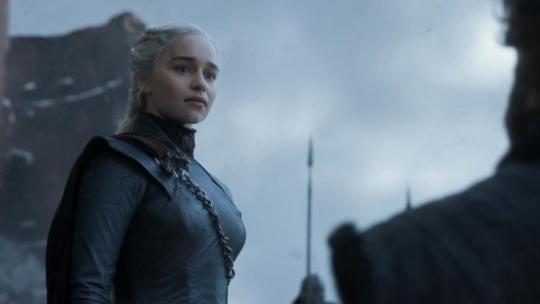
Feature
Books
David Crow
Oct 30, 2019
HBO
Game of Thrones
from Books https://ift.tt/2MYUoWo
0 notes
Text
For much of my life, I've lived at the margins of a number of faith traditions. Being raised between the Roman Catholic Church, the United Church of Christ and the Watchtower Society during my youth, my best friend in high school was a devout Hindu from Gujarat. I recall spending hours of time, in between bouts of cricket (played in the parking lot of his family's hotel) and delightful snacks prepared by his mother, immersed in conversation concerning the praxis of Sanatana Dharma, "the eternal religion". I was utterly fascinated by the iconography that graced my friend's home, with the shrines, and, especially, with the semi-annual Dandiya Raas festival (traditional Gujarati folk dance festival) that I was lucky enough to attend with him. For me, despite being devoutly raised in a faith tradition so rooted in its own other-hemispheric truth that it fueled the flames of western imperialism for hundreds of years, there was yet no doubt that the sacred was absolutely present in the Hindu practices of my dear friend. How could I then, even fathom evangelizing, as I was so instructed to do in my own church? I recall on numerous occasions being questioned, concerning why I was so free to listen to the descriptions of the faith of another, whilst not not "sharing my own". From the time I was five or six, I've had an in depth involvement with the martial arts and the appendant disciplines (calligraphy,tea, etc) of East Asia. From there came my first exposure to the practice of meditation, and through no brief series of events, some (almost) twenty-five years later I've found myself deeply rooted within the non-dual Buddhistic tradition of Zen (be it called Chan, Seon, Thien, or even Dzogchen). In some way, the Zen meditation tradition has been a strong anchor for me, with its straightforward "toolbox" approach to spirituality, lacking in comparison with other spiritual traditions, a strong sense of narrative from which the sacred may be defined and then approached. The practice of Zen is simple, sit down, shut up, and pay attention- and then maybe, just maybe, something spiritual may dawn within you. This past week, I spent several days in retreat at a Roman Catholic Benedictine monastery in Northern Missouri, oddly enough with a group of American Baptists (and the occasional Episcopalian). Entering into the rhythm of Christian monastic life, I carried with me a question proposed in perhaps new ways, from a Zen mentor, concerning the crux of that tradition, namely, unknowing, and what its identity *could be*. With this, ever running in the background of my being, I had, for the first time, a very profound experience during the practice of Eucharistic Adoration. First in the chapel of the sisters over the hill from the abbey where our group was cloistered for the week, whose charism itself is "perpetual adoration", and again unmistakably back in the abbey, as a priest fully vested in cope and humeral veil, processed reverently with the blessed sacrament from a side chapel, to place it in a monstrance on the main altar. Again. Amidst the just-out-of-reach accessibility of partaking in the daily celebration of the Eucharist, the sacred was indeed and absolutely present during these aforementioned periods of adoration. This experience of the sacred was for me, both clear and strong enough to be, what some, many perhaps would term a "conversion experience". And before anyone gets too excited- I've had many. I've heard, and discerned viscerally the call, or rather, unmistakable presence of the holy, many, many, many times. During extended periods of chanting in "Pure Land" Buddhist monasteries, in receiving a blessing by means of the touch of a ceremonial scepter to my head by an eminent Lama, spinning in the ecstatic dance of the Sufi tradition, being asperged during Gaudiya Vaishnava worship, clapping and bowing before a Shinto shrine, and even in simply beholding with my ears the adhan, or Islamic call to worship beckoning from distant minarets. In this, it would seem to me that true unknowning is being able to enter into the world of just about any "mythology", that is, any sacred narrative and therein to behold it unmistakably as reality- to perceive it as a legitimate expression of the ultimately inexpressible ground of being, on which drawing any line (or lines) gives rise to a very real if not anything but full picture of what many-to-billions call "the divine". The Zen discipline equips its adherents with tools of perception, with a spiritual vocabulary that entreats but the beat of a broken-open heart as perhaps the most refined of diction. And, herein, has been found to date, the essence of my spiritual journey, and indeed, reality. Not in the supremacy of one, or any faith tradition, nor in any prescribed inferiority. To me it rather seems, that religion, in essence, arrives at its destination to not one, but many peaks of varied mountain ranges, whose roots stretch yet from but one ground, crusting as it may the fiery core of the planet, that mirrors in intensity the core of the human spirit, seeking from the unknowing and unknowable to see and be seen. To know, and to be known. Everything else is flourish to the view. ~sunyananda
13 notes
·
View notes
Text
Title: Loving Paradoxes: A Feminist Reclamation of the Goddess Kali Author: Vrinda Dalmiya, 2000, pp.125-150
Feminist significance of the Goddess Kali
1. Why Kali, again?
Iconography of the Goddess Kali from India: construction of femininity and motherhood
Hymn;
Mother, incomparably arrayed,
Hair flying, stripped down,
You battle-dance on Shiva's heart,
A garland of heads that bounce off
Your heavy hips, chopped-off hands
For a belt, the bodies of infants
For earrings, and the lips,
The teeth like jasmine, the face
A lotus blossomed, the laugh,
And the dark body billowing up and out
Like a storm cloud, and those feet
Whose beauty is only deepened by blood.
So Prasad cries: My mind is dancing!
Can I take much more? Can I bear
An impossible beauty?
(Ramprasad 1982, 65)
Kali: both a wife and a mother and an immodest, aggressive, and grotesque wife and a terrifying, violent and self-absorbed mother.
Why, duality exists?
Passivity and tenderness of Kali
Kali, why are You naked again?
Good grief, haven't You any shame?
Mother don't You have clothes?
Where is the pride of a king's daughter?
And Mother, is this some family duty-
This standing on the chest of Your man?
(1982, 46)
Ramprasad asks: Who taught You to be so cold?
If You want to be like Your father-
Stone-don't call Yourself
The Mother.
(1982, 32)
However, Kali’s manifest form is violent and uncaring. Therefore, Kali symbolises the paradoxical dyads: passivity/aggressiveness; traditionality/unconventionality; beautiful/grotesque; tender/terrifying.
WORSHIPPING KALI/ LOVING THE MOTHER
Another Paradox
Goddess of Kali/ the love of Kali (Kali is scolded, and becomes a relentless litany of her faults and misdemeanours)
Kali-bhakti
Kali: literally means “darkness” and “time”
Goddess Kali: associated with the power of transformation – not merely in a cosmic sense, but in the personal lives of countless devotees who regard Her as the Divine Mother.
Bhakti: ‘loving devotion’ & refers to the manifold approaches of dedication to one’s patron deity.
Kali-bhakti: describes the path of loving devotion to goddess Kali.
Devotee, like Ramprasad expects spiritual liberation through Kali-worship.
West way of dualism thinking is risky
1. Orientalism
Rationality of the West vs. spirituality of the East
‘Mind’ vs. ‘body’ à cause a new hierarchy
2. Kali has been co-existing happily with patriarchal structures and the oppression of women in India. Can we [real feminists] potential in her symbolism or worship after all?
Kali, The “Mother” OF THE CHILD
Gods and Goddesses in the Indian Tradition are constituted in three layers;
1. Ichnographically represented celestial beings whose intricate biographies are narrated in mythological tales [adhidaivika]
- Kali is naked
She stands in for all women:
You’ll find Mother
In any house.
Do I dare say it in public?
…..
She’s mother, daughter, wife, sister-
Every woman close to you
What more can Ramprasad say?
You work the rest out from these hints.
(1982, 60)
As a symbol of femininity
i. As serving patriarchal purposes and emerging from male fear of female sexuality
ii. As a genuine feminine self-assertion and power, a mother who is not afraid of stepping out the conventions of motherhood to express herself – her rage and her needs.
However, Kali is more than the feminine!
2. They are vital principles of the lived-body of the devotee [adhyatmika]
Spiritual progress is equivalent to yogic control of the kulakundalini, making it rise to the "highest centre" in the crown of the head. This is the state of blissful repose.
- Kali is spelled out by the meditational metaphysics of Tantra.
[Kulakundalini: meaning ‘serpent power’]
Now cry Kali and take the plunge!
O, my Mind, dive into this sea,
...
Now, hold your breath
And jump! Kick down to where She [Kulakundalini] sits
Deep in the wise waters, a great pearl.
(1982, 54)
The ascent of the kundalini to its peak is represented ichnographically by the dancing Kali frozen into immobility (achievement) upon stepping on Shiva (the "highest centre").
3. They are principles in the environment or cosmos [adhibhautika]
- Kali’s dance is the eternal change of the natural order.
- Kali’s terrifying form is a pictorial expression of the brutal fact that everything in nature is constantly changing
- Change is really decay and finally death
Thus, Goddess is not only a suprahuman deity but is simultaneously a principle in the inner and outer realms.
An act of worship: dwelling on a deity, on a vital principle (internal to the body) and on a cosmic principle all at once.
Kali as Prakrti
- The source of everything and is thus a metaphysical “Mother”
... You are the Mother of all
And our nurse. You carry the Three Worlds
in Your belly.
(1982, 28)
Similar to the notion of TAO??? (as I mentioned before!)

The dance of Kali is an important metaphor. A dance suggests playfulness and light-heartedness. Equally importantly, it is constant movement or change. Etymologically, Kali is a feminine form of kila, which means time. But time and change are just euphemisms for decay and death. Kali is thus the paradox: She is the Primal Mother who brings forth all life even while she signifies Death. Everything that there is,everything "natural," is the vale of Death even though it is nothing other than Kali/Prakrti, the source of life.
0 notes
Text
Thurston Moore: Rock n Roll Consciousness
Though they personified the squall and squalor of 1980s Manhattan, Sonic Youth’s hearts always belonged to 1960s California. Starting with 1985’s Bad Moon Rising, Golden State roots both literal (see: Kim Gordon’s Los Angeles upbringing) and figurative (Lee Ranaldo’s Deadhead past) began to deeply entangle themselves in their knotty guitar gnarl. But where the Manson-inspired maelstrom of “Death Valley ’69” seemed to add another gallon of piss onto the grave of the hippie dream, the content and iconography of Sonic Youth’s subsequent work suggested they were secretly mourning it.
The inner-sleeve artwork for 1986’s EVOL found Thurston Moore posing like a flower child with a sitar, while a scrawled crucifix insignia—emblazoned with the words “Sonic Life”—evoked the DIY religiosity of West Coast free-love cults. And with 1987’s Sister, Sonic Youth produced the most Californian album in their canon, from the desecrated Disneyland photo on the cover to the specific geographic references, not to mention the song that proved to be the closest Gordon and Moore would ever get to their own “I Got You Babe.” After flirting with mainstream success in the early 1990s, Sonic Youth more or less carried themselves as a post-punk Grateful Dead, becoming a modern paragon of hippie-era artistic freedom but without the incense, hacky sacks, and wavy-arm dancing.
This summer marks the 30th anniversary of Sister, but in lieu of a big deluxe reissue campaign, Moore has surfaced with a solo record that similarly exhibits outer aggression as a means to achieve inner bliss. While Moore’s most recent work has seen him unleash his latent activist streak, Rock n Roll Consciousness uses its noisy guitar jams as battering rams to access more intimate, spiritual modes of expression. The title is no misnomer—on Rock n Roll Consciousness, Moore is consciously rocking, with the returning cast of guitarist James Sedwards, My Bloody Valentine bassist Debbie Googe, and Sonic Youth drummer Steve Shelley further solidifying the groundwork they laid on 2014’s The Best Day. But that sturdy foundation gives Moore the confidence to let his head float evermore freely into the clouds, atop some of the most joyous, optimistic lyrics he’s ever sung.
Rock n Roll Consciousness is an album about love—if not an album of love songs per se. Moore isn’t singing to his girlfriend here—he’s addressing mythical goddesses and the mystique of big cities at night and the changing of the seasons. Like The Best Day, the new record features lyrical contributions from London poet Radio Radieux, whose cosmic vocabulary—with its references to “the prophetess,” “peyote walkers,” “magic drums,” and “vibration love”—allows Moore to mine the ecstatic without losing his ageless, dead-cool drawl.
But if the album��s lyrics project a certain youthful idealism, musically, Moore and co. proudly dig their worn-out Converse heels into an indie-is-the-new-dad-rock ethos that trades in Sonic Youth’s abstract extremes for a tougher, more propulsive thrust. It’s more meat-and-potatoes, sure, but it’s really choice grass-fed beef with yam flan. “Exalted” unfurls like the Feelies playing at 16 rpm, before Sedwards starts channeling J Mascis channeling Eddie Hazel on what sounds like a meditative rendition of Neil Young’s “Like a Hurricane.” This melancholic reverie is rudely interrupted by a doom-metal drone that hits like a flaming gong crash, blazing the trail for Moore’s star-struck vocal to finally come in just before the eight-minute mark. “Aphrodite,” meanwhile, feels like an entire song spun out of the staccato, pin-pricked climax to “Marquee Moon,” until Googe’s hypnotic bass breakdown goads Moore and Sedwards to engage in some wah-wah warfare.
Where The Best Day proffered a somewhat uneven mix of extended odysseys and rough-hewn sketches, Rock n Roll Consciousness is much more cohesive and smoothly sequenced. Its five tracks (averaging eight minutes a piece) feel like carefully plotted epics rather than improvised excursions; the revved-up 10-minute thriller “Turn On,” in particular, is packed with hairpin twists and turns. But Moore can also reach euphoric peaks through a more direct route. “Cusp”—a cloud-parting ode to the coming of spring—is six-and-a-half sustained minutes of shimmering jangle and steady, shuffling rhythm. The song is simultaneously frantic and soothing; like a jogging-on-the-spot exercise, the surroundings may not change, but by the end, your heart is pounding and you feel light-headed. It’s the moment where this album’s core philosophies achieve their purest physical manifestation. As Moore would attest, rock’n’roll—like love itself—should instill a higher state of consciousness, while at the same time make you feel like you’re losing it.
0 notes
Photo


New York Times - January 6th 1985
By STEPHEN HOLDEN
No phenomenon illustrates more pointedly how pop music history seems to run in cycles than the overnight success of the 24-year-old pop siren known as Madonna. The month before Christmas, Madonna's second album, ''Like a Virgin'' (Sire 1-15157) sold more than two million copies. Teen-agers were lining up in stores to purchase the album the way their parents had lined up to buy the Beatles records in the late 60's. And the title song, a mildly titillating dance-rock ditty about how true love can make a girl feel ''shiny and new, like a virgin,'' is one of the fastest- selling singles in the history of Warner Bros. Records.
The singer, who was born Madonna Louise Ciccione in Bay City, Michigan, and who now lives in New York, has already become a symbol of the 50's-in-the-80's sensibility that is swamping contemporary pop culture. With a tough-cookie voice that's both coy and streetwise, Madonna's singing harks back to the rock-and-roll ''girl-group'' tradition that preceded the Beatles. But where girl groups, from the Shirelles to the Ronettes, worshipfully extolled their boyfriends' cars, haircuts and rebel poses, Madonna's point of view is decidedly more self-interested. In matters of love, she is a comparison shopper with a shrewd sense of her own market value.
The words ''shiny and new'' describe not only the way the love-smitten singer feels in the title song but the sound of the album, which was handsomely produced by Nile Rodgers, one of the masterminds of the late 70's disco group Chic. Mr. Rodgers has adapted some of the elements of Chic's sound - a scrubby guitar, glistening electric keyboards and light, strutting dance-pop rhythms - to enshrine Madonna's personality. Among other idioms, the songs gloss Philadelphia soul (''Love Don't Live Here Anymore''), orchestrated doowop (''Shoo-Bee-Doo''), frilly pop- soul (''Dress You Up,'' ''Angel''), and pop-reggae (''Material Girl''). The dance-floor fantasy, ''Pretender,'' is as elegant a piece of disco fluff as Chic at its airiest. The glittering unfussy arrangements are spun around Madonna's kewpie-doll voice like swirls of cotton candy with a skill that makes ''Like a Virgin'' this year's definitive model of danceable urban teen-pop.
Madonna is the brassiest star to emerge so far among the new breed of singing starlets that have been spawned by music-video. Wrinkling her pretty doll face into a provocative pout and exposing her bare midriff, she sometimes suggests a contemporary equivalent of blonde bombshells like Marilyn Monroe, Mamie Van Doren and Jayne Mansfield. Madonna's songs have an attitude to match. ''The boy with the cold hard cash is always Mister Right,'' she sings, in ''Material Girl,'' the song that opens her new album. Written by Peter Brown and Robert Rans, ''Material Girl'' is an 80's teen-pop version of ''Diamonds Are a Girl's Best Friend,'' with references to ''credit,'' ''interest'' and ''saving pennies.'' In ''Dress You Up,'' the singer pursues a man about whom we're told only two things - he sleeps on satin sheets and wears custom-made English suits.
By enthusiastically playing a gold digger, Madonna is diametrically opposed in spirit to the young pop music heroines of a decade ago. Carole King, Joni Mitchell and Carly Simon, the rock singer-songwriters who were at the peak of their popularity in the mid-70's, wrote probing confessional songs that tried to expand the vocabulary of adult pop music into an art form. But Madonna's music, like so much of the new wave and disco that reacted against such literary gentility in pop, revels in rock-and-roll basics and cartoon fantasies of self- gratification. Carole King, in particular, stood for an unglamorous socially concerned humanism. Madonna, by contrast, offers only impetuous romantic fantasy to those who can afford it. Like most of today's mainstream pop idols, the world outside of her own juvenile dreams barely exists. And when it does come into view, it's not a place to be understood but a jungle to be navigated.
Born out of punk and disco in the late 70's, the anti-intellectual, artifice-flaunting female pop traditon that Madonna represents found its first heroine in the sullen punk-rocker Debbie Harry of Blondie. Since then, more and more post-new wave pop stars have followed Miss Harry's example and rejected artistic goals for deadpan ironic attitudinizing. The new generation of MTV-bred pop stars have happily traded in their complicated real selves to become preening music-video products with self-christened brand names like Billy Idol, Prince, Duran Duran, Wham and Madonna. They are real- life cartoon figures who, instead of dealing in musical literature, find it easier to traffic in video iconography. Madonna, who has rarely performed in concert, is the best evidence yet that a strong live act is no longer a prequisite to pop stardom. A telegenic image is far more important.
Eventually, of course, the cycle will swing back. A younger generation will reject the selfishness and superficiality of the ''Material Girl,'' with her mirror, her schemes and her money, and demand something more substantial. But the pendulum can't be forced into reverse. Until it swings of its own accord, Madonna, the hottest female star in pop, will stand as a very revealing sign of the times.
0 notes